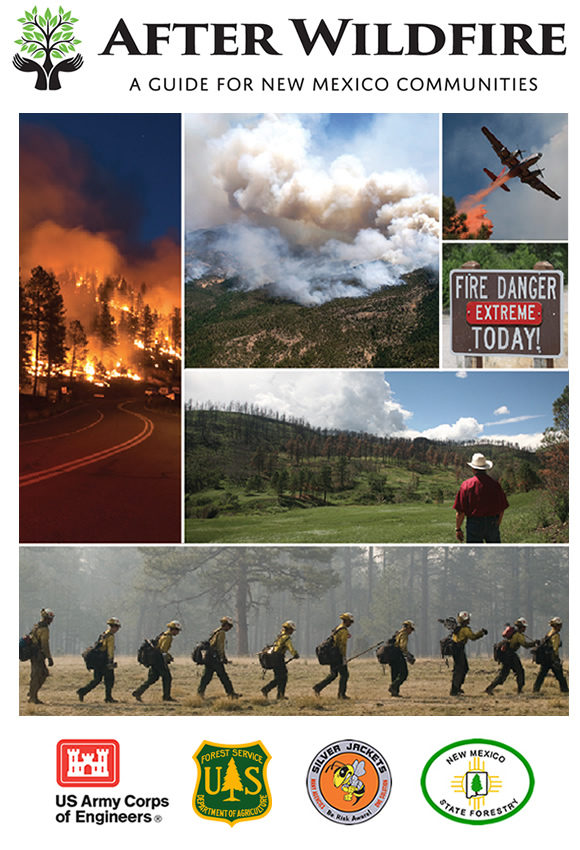
Welcome to the After Wildfire Guide
A Guide for New Mexico Communities
Experiencing a destructive wildfire can be devastating. This guide was written to help New Mexico communities recover after wildfire. It includes information on how to mobilize your community, a list of resources available to communities and individuals for assistance, and a technical guide with information about post-fire treatments to address the catastrophic effects of a wildfire on the land and to prepare for potential flooding. If you are reading this guide before a wildfire occurs, use it to help you plan ahead.
This guide is intended to provide useful information during this difficult time, and to start you on the road to recovery.
Immediate Safety
Although wildfire damage can be immense, often the danger is not over after the flames are put out. Flash flooding, structural damage, road instability and damaged trees are just some of the dangers that landowners face after a wildfire. Keep these tips in mind:
If you feel you are in danger, call 911 or your local emergency number.
- Stay away from your home or business until fire officials tell you it is safe to return.
-
Flash floods are a very real and potentially deadly hazard after a wildfire, particularly as a result of rain falling over a burned area upstream of your location. Stay away from storm channels and arroyos (ditches are deadly, especially after a wildfire). Keep a battery-powered radio to listen for emergency updates, reports of weather and flash flooding, and news reports. For more information, visit our flood section here.
-
Have an evacuation plan in place and make sure all family members know it in case you need to leave your home for any reason.
-
Do not drink or use water from the faucet until emergency officials say it is okay; water supply systems can be damaged during wildfires or flooding. Visit the NMED Drinking Water Bureau website for more information, or call 877-654-8720 Monday - Friday, 8-5, for more information.
-
Be aware of and use extreme caution around trees, power poles and other tall objects that may have lost stability during the fire. Most burned structures and surfaces will be unstable. Stay out of burned forests in windstorms as burned trees are easily downed by wind. Do not touch any power lines.
-
Utilities: If there is no power, check to make sure the main breaker is on. If the breakers are on and power is still not present, contact the utility company. If you have a propane tank or system, contact a propane supplier, turn off valves on the system, and leave valves closed until the supplier inspects your system. If you have a heating oil tank system, contact a heating oil supplier for an inspection of your system before using.
-
Before beginning any cleanup effort, document damage with photographs and contact your insurance carrier.
-
Finally, use caution and good judgment. Ultimately you are responsible for your own safety and well-being.
-
Keep a “fire watch.” That means look for smoke or sparks throughout the house and on rooftops (such as in gutters), etc. Look for ash pits or hidden embers. Stay away. They can burn you.
-
Use a battery-powered flashlight to inspect a damaged home. (Note: the flashlight should be turned on outside before entering – the battery may produce a spark that could ignite leaking gas, if present).
-
For information on caring for pets and livestock after wildfire, click here.
-
Finally, use caution and good judgment. Most burned structures and surfaces will be unstable. Ultimately you are responsible for your own safety and well-being.
Additional Safety Resources
Wildfire
- Wildfire Information: click here.
Weather and Emergency Alerts
- The National Weather Service provides active alerts on weather across the nation.
- NOAA Weather Radio provides 24/7 information on watches, warnings and advisories from the National Weather Service. It does not cover all areas of New Mexico, and does require a special receiver that can be purchased at many retail outlets for less than $40 USD.
- The Emergency Alert System broadcast flash flood warnings commercial radio and TV.
- Wireless Emergency Alerts (WEA) are emergency messages sent by authorized government alerting authorities through your mobile carrier, and include flash flood warnings. Mobile users are not charged for receiving these text-like alerts and are automatically enrolled to receive them.
- FEMA recently launched an app that provides email alerts and text messages to the general public.
- Third party sources that deliver email and weather alerts are listed here.
- Nixle provides free text and email alerts anywhere in the nation.
Water and Smoke
- The NMED Drinking Water Bureau website provides information on drinking water safety, or call 1-877-654-8720 Monday - Friday, 8-5 pm.
- Smoke Inhalation and your health: for information on how to help protect your health from wildfire, visit the New Mexico Department of Health here.
Pets and Livestock
- Contact your local animal control office or county extension office to find out if a pet or livestock shelter has been set up. For contacts and information, visit our 'Who Can Help' section on animals here.
Mobilizing Your Community
Mobilizing your community is a crucial part of the process of recovering from a wildfire. This guide provides information to help local governments and community leaders get started on recovery coordination.
Wildfires that create wide-scale damage require a community-scale response for recovery. One of the greatest challenges is coordinating such a large effort. This section provides key points to help you get started.
Establish a Post Fire Coordinator
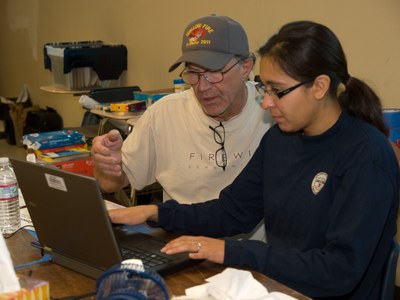 In small communities, subdivisions or neighborhoods, residents should appoint a Post Fire Coordinator (or a few coordinators) to work directly with local, state or federal agencies, emergency response officials and others others to help in a coordinated response. The Post Fire Coordinator does not need to be an elected official, they can be a community volunteer such as the lead of a Neighborhood Watch Group or of a Firewise Community effort.
In small communities, subdivisions or neighborhoods, residents should appoint a Post Fire Coordinator (or a few coordinators) to work directly with local, state or federal agencies, emergency response officials and others others to help in a coordinated response. The Post Fire Coordinator does not need to be an elected official, they can be a community volunteer such as the lead of a Neighborhood Watch Group or of a Firewise Community effort.
It can also be someone who is just a member of the community; two sisters, just 20 and 24, filled this role after a freak tornado hit their town. To see their inspiring story and the resource they built (recovers.org), visit their TED talk.
The coordinator will need to work closely with local elected officials, emergency response personnel, volunteers and other stakeholders to address needs and seek assistance. They will need to play a strong leadership role to help their community on the path to recovery.
Skills that are helpful for the coordinator to have include:
- Proven management skills and knowledge of the community
- Internet skills (assists in communication with the public or using a site such as recovers.org)
- Experience with government agencies and programs and working across jurisdictions
- Someone that already has a community network in place
- Willing to engage throughout a fire, and during and after the BAER (Burned Area Emergency Response)
- Bilingual skills may be needed in some areas
You may want to plan for multiple coordinators to help share responsibilities. for example, there could be coordinators for different phases such as a coordinator during the fire, and another to coordinate the response after the wildfire (focusing on rebuilding, flooding, restoration, etc.).
Support for the Post Fire Coordinator(s)
While the Post Wildfire Coordinator should handle many of the community coordination tasks, others are responsible for local governance and incident response. Local officials will be responsible for providing governance which includes serving as the collective decision-making body of the community, ensuring fiscal accountability and responsibilities are met, providing for public health and safety, and keeping community members informed. The local emergency manager will work with state and federal partners to handle the disaster response and immediate needs.
The Post Fire Coordinator is a very important position after a wildfire. However, the job will be demanding and may be emotionally taxing. The coordinator should get help from volunteers, assess community needs, build a team for support, and reach out for immediate resources. For help with emotional resiliency and support, see these resources.
Clearly Identify Community Response Roles
 Responsibility for the numerous tasks required for community wildfire response is divided among many different people. Ensure everyone knows what each person’s roles and responsibilities are. It is very important for the Post Fire Coordinator to know who the agency and local government representatives are and the role each one plays following a disaster. The Post Fire Coordinator should also be able to communicate that information to others.
Responsibility for the numerous tasks required for community wildfire response is divided among many different people. Ensure everyone knows what each person’s roles and responsibilities are. It is very important for the Post Fire Coordinator to know who the agency and local government representatives are and the role each one plays following a disaster. The Post Fire Coordinator should also be able to communicate that information to others.
Ensure Assigned Roles are Not Overstepped
The Post Fire Coordinator for your community needs to ensure that the people on their team do not overstep their assigned roles. The Post Fire Coordinator should familiarize himself or herself with the roles of government response teams. Likewise, elected officials should not infringe upon the responsibilities of the emergency response team, and must not act individually. Many decisions after a wildfire must be made by the collective governing body.
Examples of Government Response Teams & Systems
There are several government response teams that your community is likely to interface with after a wildfire. These include:
- BAER Teams: BAER (Burned Area Emergency Response) teams work on federal land after a wildfire to mitigate damage caused by the wildfire, and often provide information about a wildfire to the public and partners. BAER teams work with other federal, state, local and tribal governments informing those agencies of the risk to downstream communities and areas after a wildfire. Click here for a pdf about BAER teams.
- Incident Command System: Large wildfires will have an Incident Command System. Find out more so you know how to best communicate and interface with this system.
Assess Your Needs
Who do you need at the table to help with recovery? Assessing your needs is an important step in mobilizing your community. The community's Post Fire Coordinator should identify the tasks needed in a post wildfire situation (a ‘needs assessment’). The Post Fire Coordinator should then build a community team of support to carry out the identified tasks (this team is different from government emergency response teams that come up elsewhere in this guide). Answering the following questions can help you identify appropriate individuals for your team.
- Is there paid staff available to help after a wildfire?
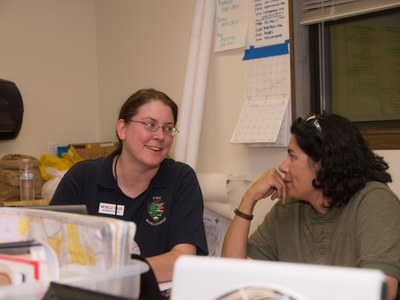
- Who knows the Incident Command System (ICS)?
- Who has technical and engineering skills to assist with on-the-ground rehabilitation?
- Who has writing skills to prepare grant proposals and to submit documents required to apply for assistance?
- Should your community (or individuals) raise fund from private donations to fill the gaps of the help provided?
- Who are the administrators that can handle grants and attend funding-related meetings?
- Who has accounting skills? Meticulous bookkeeping is critical!
- Who can assist a community with immediate shelter, food and medication needs?
- Who can provide emotional support and counseling?
-
Who has mapping (Geographic Information Systems) skills?
- Who has local knowledge of the landscape and any pre-existing issues such as eroded areas?
- What are key values that are at risk after a wildfire, and can something be done to protect these? Refer to our flooding and post-fire treatments sections of the website.
- Who can help neighbors with clean up, building fences, etc? For example, there may be elderly people who can not do it themselves, or neighbors who have so much to do it is overwhelming.
- Who has knowledge of the local land tenure? This may be especially important for Tribes and Pueblos, or for Land Grant communities.
- Determine if you are going to use volunteers for any of the above tasks. If so, you will need someone to recruit and manage volunteers. For tips on working with volunteers, click here.
- To get you started on who might help fill these needs, visit the Who Can Help section.
Communication
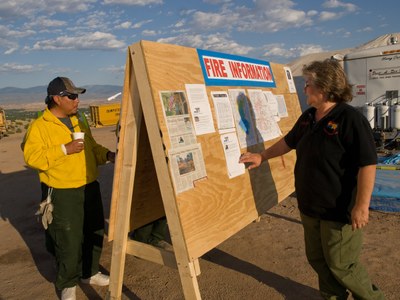 An important step in mobilizing your community after a wildfire is to develop a process of communication. Below are considerations for developing a communication plan in the wake of a destructive wildfire.
An important step in mobilizing your community after a wildfire is to develop a process of communication. Below are considerations for developing a communication plan in the wake of a destructive wildfire.
- Point of Contact: Let the appropriate people know who the Post Fire Coordinator is and how and when to reach them.
-
Communication with Multiple Entities: Determine how local officials, emergency response teams, stakeholders, and volunteers will interface and communicate with your community team built upon your needs assessment.
-
Getting the Word Out: Decide the best way to inform the broader community through outreach such as public meetings, phone calls, radio, TV or social media. Be creative and resourceful; for example, after the Tres Lagunas fire, San Miguel County Emergency Management set up local radio reporters in the canyon so residents had access to 24 hour flood alerts.
-
Online tools such as recovers.org can help you communicate with the public and match volunteers to needs.
-
Use the 'After Wildfire Toolkit' , which provides communication templates for you to customize such as door hangers, press releases and public service announcements.
-
Communicate Hazards that Exist After a Wildfire: Convey post-wildfire hazards such as those covered in immediate safety. Flooding after wildfire is a common hazard, for example. For more information on post wildfire flooding, visit our Flood Information section. For actions to take to help the land and to help mitigate flood risk, visit our Post-Fire Treatments section.
- Emergency notification: Find out if your local government and institutions (like labs and universities) have an emergency notification system that allows emergency officials to alert residents and businesses to emergency situations and relay life-saving information. Encourage your team members and residents to sign up if the system requires registration. Third party systems such as Nixle (a free alert system) also exist.
Reach Out for Immediate Resources
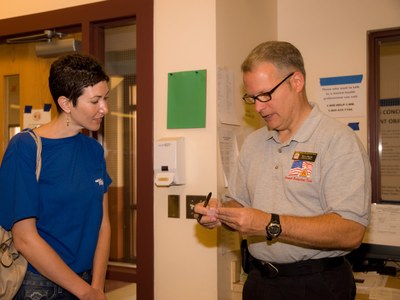 After a destructive wildfire, communities are in need of assistance and resources. However, many grants take time to apply for and receive. Early in the response phase, reach out for immediate resources.
After a destructive wildfire, communities are in need of assistance and resources. However, many grants take time to apply for and receive. Early in the response phase, reach out for immediate resources.
- The New Mexico Department of Homeland Security and Management (NMDHSEM) is often the best place to start and can assist communities in identifying resources. The community Post Fire Coordinator or elected official working on behalf of a community may call them at 505-476-9635. The NMDHSEM and Federal Emergency Management Agency (FEMA) work together to respond to disasters and collaborate on both public assistance and hazard mitigation programs.
- Collaborate and network with outside entities. For example, reach out to the New Mexico Association of Counties and the New Mexico Municipal League. You may be able to learn from officials who have recently been in a similar situation.
- Think about reaching beyond state borders for assistance: Consider reaching out to other states that have teams or experiences that can help you. For example, after the Little Bear Fire in Ruidoso the community hired a team from Austin to assist with the post-fire recovery. Additionally, Team Rubicon is a group that "unites the skills and experiences of military veterans with first responders to rapidly deploy emergency response teams."
- The American Red Cross responds to disasters 365 days a year and can assist impacted individuals with their immediate emergency needs: http://www.redcross.org/newmexico, Call 1-800- RED CROSS, (1-800-733-2767).
- Search for Additional Financial Assistance: Agencies and organizations provide a variety of programs and services to assist communities and individuals recovering from wildfire. To help you get started, we have provided information and links to financial tips and opportunities for assistance.
Working With Volunteers
The amount of work to be done in the wake of a disaster can be daunting, and with wildfire, recovery often takes years of work. Volunteers can help your community recover from wildfire by carrying out the projects you do not have allocated resources for. Here is a list of tips and suggestions to aid you in successfully utilizing volunteer help.
1. Identify a Volunteer Coordinator: This should be someone personable and organized, with prior management experience. Your coordinator can take a lead in:
- Handling volunteer requests
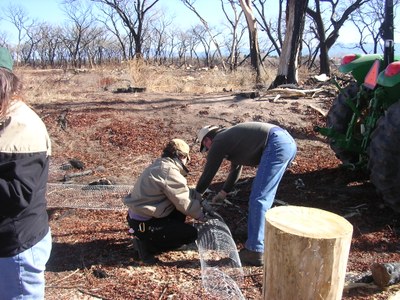
- Handling volunteer offers and screening volunteers
- Creating and maintaining the volunteer database
- Tracking of volunteers, services and donations
- Matching the right volunteer with the right project
- Reviewing project proposals
- Researching and obtaining funding and resources for projects
- Recruiting volunteers through social media, press releases, and outreach opportunities, if needed.
2. Assess Resources: Working with the skills and the tasks you have identified for your community, ask yourself the following questions:
- What jobs need to be done that we do not have the resources for?
- What tasks can be done by volunteers?
3. Recruit Volunteers: Typically, volunteers with the following skills will be needed:
-
Patient, kind, knowledgeable people to answer telephones
-
Well-organized and detail-oriented people to handle volunteer applications, enter information into computer databases, and make follow-up calls
-
People willing to get dirty (cleanup, filling sandbags, raking, seeding and related activities). When working with volunteers on physical jobs, safety is paramount. Ensure people are properly trained, and keep groups small (about seven people with each volunteer leader; the leader should be trained in the work you are implementing and have very brief written instructions on the task at hand). Keep instructions simple and clear for hands-on work.
-
Seasoned and strong outdoor types who can lift and place heavy wattles, logs or bales of straw
-
People with professional skills such as grant writing, accounting, legal skills, and media and outreach skills
4. Motivate volunteers, but keep them from going "overboard": volunteers can injure themselves or experience overwhelm or fatigue. Monitor volunteer well-being to avoid dangerous situations.
5. Have a plan for addressing liability and injury issues. This includes the creation of a volunteer waiver and release of liability forms. These forms can also include a volunteer or work agreement to help ensure your projects get completed.
6. Find Tasks for People Who Want To Help: If possible, rather than turn away someone who wants to volunteer, try to find the right job for that person. Allowing community members to pitch in and help out not only provides needed labor but can also promote community cohesion and advance their personal healing process. To help match volunteers with needs, use online resources such as recovers.org.
6. Maintain a Volunteer Database: Developing a volunteer database is an important step. Each project and community will require different information, but at a minimum should include:
- First Name, Last Name (or name of organization and primary contact)
- Address, City, County, State, Zip Code
- Work Phone and extension, Home Phone, Mobile Phone
- Email Address
- Date of Birth (or adult or minor)
- Skills/Type of work volunteer is willing to perform and any relevant experience or expertise
- Availability
Planning is Important
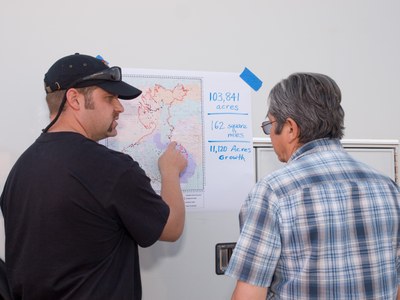 You may not have to start planning the recovery process from scratch. A growing number of New Mexico communities have adopted an all-hazard mitigation plan that addresses wildfire response. If your county, tribe, pueblo or municipality already has a plan, many of the tasks on the next few pages will have been done for you. If your community doesn't have a plan in place, this guide will help you identify steps to take.
You may not have to start planning the recovery process from scratch. A growing number of New Mexico communities have adopted an all-hazard mitigation plan that addresses wildfire response. If your county, tribe, pueblo or municipality already has a plan, many of the tasks on the next few pages will have been done for you. If your community doesn't have a plan in place, this guide will help you identify steps to take.
If you are reading this before a wildfire has occurred, the most important thing you can do is plan ahead.
Does my Community Have a Plan?
To see the status of your community's Hazard Mitigation Plan, check the 'Mitigation' page from the New Mexico Department of Homeland Security and Emergency Management. For links to existing New Mexico Community Wildfire Protection Plans from State Forestry, which may be useful in a post-wildfire situation, click here. You may also try an online search for a plan for your community; for example, Angel Fire has a wildfire plan here that does not appear on the other sites mentioned.
Key Items for Planning
In addition to resources such as a Hazard Mitigation Plan, keep these key points in mind:
- Document your community or home through photographs in case you need to use images after a wildfire for financial purposes.
- If a wildfire happened, who would I need at the table to help with the recovery process? Think about social recovery as well to provide for items such as food, medication, supplies and support such as counseling.
- How will your community come up with match for grant funding? Planning ahead for finances and for volunteers, etc. can assist your community in recovery.
- If a wildfire occurs, how do we address the threat of post-wildfire flooding? Often fires in New Mexico and in the southwest are followed by monsoon rains; what can we do to protect our water supply and communities?
Who Can Help?
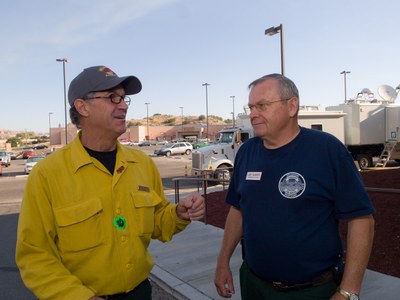 This section describes many of the programs and services provided by agencies and non-profits.
This section describes many of the programs and services provided by agencies and non-profits.
Please note that programs and funding levels can change from year to year, and assistance may not always be available.
When large wildfires affect an entire community, there are usually public meetings to provide current information on services and programs available. You may also find additional assistance from community volunteers and local organizations that are not included here.
Assistance for Communities
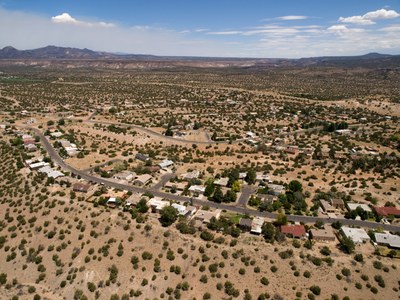
Since post-fire flooding is a real threat in New Mexico, you need to immediately assess the risk that flash flooding poses. Your first task is to identify what funds are available in the community for immediate use, and to prioritize projects that will provide the most expedient protection with those funds.
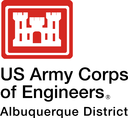 Continuing Authorities Program: US Army Corps of Engineers
Continuing Authorities Program: US Army Corps of Engineers
This fund is for relatively small projects dealing with floodplain management, flood control, ecosystem restoration, erosion control and stream bank protection. This program is broad, including activities such as stream bank erosion protection, modifications to existing infrastructure, and more. It is funded by Congress.
 Emergency Flood Protection: US Army Corps of Engineers
Emergency Flood Protection: US Army Corps of Engineers
The US Army Corps of Engineers can provide emergency assistance during flood events. USACE emergency assistance is intended, by law, to be temporary in order to meet immediate threats. Through this program, USACE can provide technical assistance to State and local governments with regard to emergency preparedness and planning activities. Assistance is intended to develop contingency plans, evacuation plans, and exercises to lend expertise in both areas.
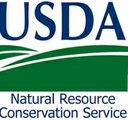 Emergency Watershed Protection: Natural Resources Conservation Service
Emergency Watershed Protection: Natural Resources Conservation Service
The Emergency Watershed Protection (EWP) program provides technical and financial assistance to safeguard people and property following natural disasters, such as floods, fires, wind storms, earthquakes, and drought.
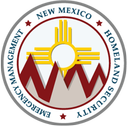 Flood Risk Evaluation Prior to Flooding: NM Department of Homeland Security and Emergency Management
Flood Risk Evaluation Prior to Flooding: NM Department of Homeland Security and Emergency Management
This program's goals are to reduce flood risk prior to an event, and partners with Federal and non-Federal partners to provide hazard information, technical services, and planning guidance free of charge to qualified communities and Tribal governments.
 Hazard Mitigation Grant Program: NM Department of Homeland Security and Emergency Management
Hazard Mitigation Grant Program: NM Department of Homeland Security and Emergency Management
The New Mexico Department of Homeland Security and Emergency Management (NMDHSEM) is a resource for communities after the Governor has issued a State of Emergency, or after a Presidential Disaster Declaration or a Fire Management Assistance Grant (FMAG) declaration . The purpose of the program is to implement long-term hazard mitigation measures. DHSEM may also have information on other programs and resources available to your community after a wildfire.
 Permanent Flood Protection Solutions: US Army Corps of Engineers
Permanent Flood Protection Solutions: US Army Corps of Engineers
The US Army Corps of Engineers has the authority to construct large-scale flood risk management (FRM) projects, including dams and engineered levees, through the Civil Works Program. Smaller-scale projects may be constructed through the Corps' Continuing Authorities Program.
 Tribal Partnership Program: US Army Corps of Engineers)
Tribal Partnership Program: US Army Corps of Engineers)
This program enables the US Army Corps of Engineers to assist on a reconnaissance study of various water resources and related issues with Pueblos and Tribes. Examples of topics include flood damage reduction, environmental restoration and protection, watershed planning, and cultural resources studies.
 Regulatory Program Authority: US Army Corps of Engineers
Regulatory Program Authority: US Army Corps of Engineers
The US Army Corps of Engineers (USACE) can assist with permitting after a wildfire has occurred. A permit is required from the USACE for activities involving discharge of fill or dredged materials into bodies of water in the US. Dredged material includes the redistribution of rocks, gravel and sediments already in the stream, lake, pond, wetland, etc.
 Soil and Water Conservation Districts
Soil and Water Conservation Districts
Your local Soil and Water Conservation District (SWCD) may be able to provide help after a wildfire or natural disaster. For a listing of your SWCDs, visit the New Mexico Association of Conservation Districts (NMACD) website or call them at (575) 361-1413. For a list of districts and phone numbers, click here.
 New Mexico Environment Department: Ground Water Quality Bureau
New Mexico Environment Department: Ground Water Quality Bureau
The Ground Water Quality Bureau protects New Mexico’s groundwater resources as mandated by the Water Quality Act and the New Mexico Ground and Surface Water Protection Regulations (20.6 NMAC) and identifies, investigates, and cleans up contaminated sites to protect human health and the environment.
US Army Corps of Engineers: Continuing Authorities Program (CAP)
What are the Program Objectives? Several authorities come under the CAP program. Some of the most relevant ones are listed below.
1) Aquatic Ecosystem Restoration, (Section 206): Improves and restores aquatic ecosystems in a cost-effective manner to improve the environment and add value to the public. The Reconnaissance phase is at 100% Federal expense. The Feasibility phase is cost shared 50/50. Construction is cost shared 65% Federal and 35% Non-Federal. It has been used extensively by Tribes to restore the Bosque along the Rio Grande.
Click here for an information sheet about Section 206, including a sample request for assistance.
2) Emergency Stream bank and Shoreline Erosion Protection (Section 14): Provides emergency stream bank and shoreline protection to prevent damage to public facilities such as roads, bridges, hospitals, schools and water treatment plants.
Click here for an information sheet about Section 14, including a sample request for assistance.
3) Flood Risk Management (Section 205): Modifications to existing infrastructure to provide protection from frequent or recurring flooding; planning and construction of flood control works such as levees, channels and dams.
Click here for an information sheet about Section 205, including a sample request for assistance.
Click here for an information sheet about Section 204, including a sample request for assistance.
Click here for an information sheet about Section 1135, including a sample request for assistance.
Who Can Apply? USACE resources can only be requested by a State Emergency Management Agency or by Tribal governments, and can only occur once State, Tribal and local governments have committed all available resources (i.e., workforce, supplies, equipment, funds, National Guard assets, etc.). However, assistance can be requested at anytime.
Are Matching Funds Required? Yes, projects are cost shared and require no further congressional authorization to proceed to construction.
When can assistance be requested? Assistance can be requested at anytime.
When Can I Expect To Receive My Funds? Funds are allocated based on the available national budget and allocated based on assigned rank at USACE Headquarters.
Contact Name: CrystalLin Medrano
Contact Phone Number: (505) 342-3686
Contact Email: cespa-eoc@usace.army.mil
NMDHSEM Hazard Mitigation Grant Program
What is it? The New Mexico Department of Homeland Security and Emergency Management (NMDHSEM) administers the Hazard Mitigation Grant Program (HMGP) utilizing FEMA funding. HMGP provides grants to local governments, tribal entities and State agencies to implement long-term hazard mitigation measures. The purpose of HMGP is to reduce the loss of life and property due to natural disasters and to enable mitigation measures to be implemented during the immediate recovery from a disaster. HMGP is authorized under Section 404 of the Robert T. Stafford Disaster Relief and Emergency Assistance Act, Title 42, United States Code 5170c.
Who Can Apply? Local governments and tribal entities with a FEMA approved Hazard Mitigation Plan. This program can only be applied for after a Presidential disaster declaration or a Fire Management Assistance Grant (FMAG) declaration.
Are Matching Funds Required? Yes, 25% of the funds must come from a non-federal source.
Program Website: https://www.nmdhsem.org/administrative-services-bureau/administrative-services-bureau-grants/hazard-mitigation-grant-program-hmgp/
Department Website: www.nmdhsem.org
Emergency Watershed Protection
What is it? Through EWP, NRCS reduces the threat to life and property by providing assistance to prevent further damage from flooding, runoff, and erosion. EWP work may include repairing existing water controls (i.e., levees, dikes, or other flood control structures), and removing debris and sediment from watercourses to prevent further damage in the event of subsequent storms.
Who Can Apply? Communities. The EWP must be sponsored by a public entity such as a qualified tribal organization, a division of state government, a city, county or special district (irrigation, conservation, etc.). An eligible entity must apply within 60 days of the event which caused the impairment. The 60 day "clock" generally starts when the event starts.
Are Matching Funds Required? Yes. The NRCS will pay up to 75% of construction costs of eligible emergency treatments.
When Can I Expect To Receive My Funds?: Timing of funding depends on the availability of funds in the program at the national level. If an eligible sponsor has matching funds available, EWP funds are available (nationally), and NRCS determines that a specific situation falls under the "exigency" authorities (generally requiring immediate action to reduce a threat to human life as well as other program eligibility considerations), funding can occur within days.
Contact Name: Kenny Branch, EWP Program Coordinator or Kristin Graham Chavez, Assistant State Conservationist for Programs
Kenny Branch Phone Number: (505) 761-4454
Kristin Graham Chavez Phone Number: (505) 761-4404
Contact Email: Click here to find your NRCS Area Office contact information
Program Website: http://www.nrcs.usda.gov/wps/portal/nrcs/main/nm/programs/financial/ewp/
US Army Corps of Engineers: Emergency Flood Protection
What is it? Under Public Law 84-99, USACE can provide emergency assistance during flood events. USACE emergency assistance is intended, by law, to be temporary in order to meet immediate threats. USACE can provide technical assistance to State and local governments with regard to emergency preparedness and planning activities. Assistance is intended for State and local agencies to develop contingency plans, evacuation plans, and exercises to lend expertise in both areas.
Post-Flood Response: Following a flood event, but prior to a Presidential declaration pursuant to the Stafford Act, USACE may provide Post-Flood Response assistance. Post-Flood Response activities are limited to actions necessary to save lives and protect public facilities, and residential or commercial developments. Post-Flood Response assistance by USACE can include clearance of debris from transportation routes, critical infrastructure, and water courses when it is required to prevent loss of life or significant damage to public property. A written request for Post-Flood Response from the Governor of a State to the USACE District Commander must be provided concurrently with or immediately after the Governor's request for a Presidential disaster declaration under the Stafford Act. This request must indicate that the recovery work is beyond the capability of the State to accomplish; identify specific damage locations; and detail specific requirements for USACE assistance. USACE assistance may be provided for a maximum of ten (10) days from the date of receipt of the Governor’s request for assistance. No work, including contract work, can be performed after the 10-day period expires. No work can be initiated if a Presidential declaration request is denied.
Advance Measures: USACE may build Advance Measures flood damage reduction projects on a case-by-case basis. Specific areas that have been impacted by forest fires leaving denuded terrains will be considered based on National Weather Service forecasted rainfall models and expected impacts to life and improved property. USACE may perform Advance Measures prior to flooding or flood fighting activities to protect against and mitigate loss of life and significant damages to urban areas, public facilities, and/or critical infrastructure. Advance Measures must be in response to an “imminent threat of unusual flooding” with the potential to approach an area's flood of record, a catastrophic level of flooding, or a greater than 50-year level of flooding. Activities are limited to the protection of life and the protection of public facilities/infrastructure in imminent danger of flooding, and the law specifically excludes assistance to individual homeowners and businesses, including agricultural property.
Who Can Apply? USACE resources can only be requested by a State Emergency Management Agency or by Tribal governments, and can only occur once State, Tribal and local governments have committed all available resources (i.e., workforce, supplies, equipment, funds, National Guard assets, etc.).
When Can I Expect To Receive My Funds?: Funding availability is subject to the budget cycle.
Contact Name: CrystalLin Medrano
Contact Phone Number: (505) 342-3686
Contact Email: cespa-eoc@usace.army.mil
NMDHSEM Flood Risk Evaluation Prior To Flooding
What is it? The New Mexico Department of Homeland Security and Emergency Management (NMDHSEM) administers the Flood Mitigation Assistance Grant Program (FMA) utilizing FEMA funding. FMA provides grants to local governments, tribes and State agencies on an annual basis to mitigate flood damaged properties and to reduce or eliminate claims under the National Flood Insurance Program. FMA is authorized under Section 1366 of the National
Flood Insurance Act of 1968, as amended, Title 42, United States Code, 4104c.
Who Can Apply? Local governments and tribal entities with a FEMA approved Hazard Mitigation Plan. This program can only be applied for during the annual cycle and must mitigate flood risk for structures insured through the National Flood Insurance Program.
Are Matching Funds Required? Yes, 25% of the funds must come from a non-federal source.
Program Website: www.nmdhsem.org/Grants.aspx
Department Website: www.nmdhsem.org
USACE Permanent Flood Protection Solutions
What is it? USACE has the authority to construct large-scale flood risk management (FRM) projects, including dams and engineered levees, through the Civil Works Program. Smaller-scale FRM projects may be constructed through the Corps' Continuing Authorities Program. Section 205 of the Flood Control Act of 1948 provides authority to construct FRM projects with up to a $7 million Federal cost.
Who Can Apply? USACE resources can only be requested by a State Emergency Management Agency or by Tribal governments, and can only occur once State, Tribal and local governments have committed all available resources (i.e., workforce, supplies, equipment, funds, National Guard assets, etc.).
Are Matching Funds Required? Yes, these projects are cost-shared 65/35 Federal/non-Federal. FRM projects are cost-shared and require a non-Federal sponsor. Cost-sharing varies from feasibility phase (50/50 Fed/non-Fed) to construction phase (65/35 Fed/non-Fed). However, Assistance can be requested at anytime.
When Can I Expect To Receive My Funds?: Funding availability is subject to the budget cycle.
Contact Name: CrystalLin Medrano
Contact Phone Number: (505) 342-3686
Contact Email: cespa-eoc@usace.army.mil
USACE Regulatory Program Authority
What is it? Under Section 404 of the Clean Water Act a permit is required from the USACE for activities involving discharge of fill or dredged materials into waters of the United States (WOUS). This requirement is not waived in emergency situations. USACE regulations at 33 CFR 325.2(e)(4) define an emergency as a situation that “…would result in an unacceptable hazard to life, a significant loss of property or an immediate, unforeseen and significant economic hardship…”Projects associated with emergency and disaster response situations will receive priority review and expedited response. Potential responses include informing the applicant that a permit is not required for the proposed work, that the project meets the terms and conditions of an issued general permit, or that an individual permit is required.
Who Can Apply? Any party proposing to discharge fill or dredged material into a WOUS. Applications may be submitted at anytime.
Contact Name: CrystalLin Medrano
Contact Phone Number: (505) 342-3686
Contact Email: cespa-eoc@usace.army.mil
Program Website: http://www.spa.usace.army.mil/Missions/RegulatoryProgramandPermits.aspx
Frequently Asked Questions about USACE Permits in an Emergency Situation:
Click here.
Pueblos and Tribes: USACE Tribal Partnership Program
What is it? This is a study authority that enables the Corps to spend up to 100K on a reconnaissance study of various water resources and related issues. Specified topics include flood damage reduction, environmental restoration and protection, watershed planning, cultural resources studies, and “such other projects as the Secretary determines to be appropriate,” thus opening the door to many potential kinds of study. Additionally, there are individual authorities for specific projects or programs that are included in Water Resources Development Act (WRDA) laws by Congress as a result of requests from constituents. Some of these apply exclusively to Tribes.
Who Can Apply? USACE resources through this program can only be requested by Tribal governments, and can only occur once Tribal and local governments have committed all available resources (i.e., workforce, supplies, funds, etc.). Assistance can be requested anytime.
Are Matching Funds Required? Yes, if a Federal interest is identified during the reconnaissance phase, a feasibility or watershed assessment cost-share agreement is signed and the project moves into the next phase. Typically, the cost share is 50/50 and in-kind contributions are allowed; watershed planning, however, is cost-shared 75/25. The Bureau of Indian Affairs must be contacted during the course of a study.
When can assistance be requested?
Assistance can be requested at anytime.
When Can I Expect To Receive My Funds?
Funds are allocated based on the available national budget and allocated based on assigned rank at USACE Headquarters.
Contact Information:
Contact Name: Ronald Kneebone
Phone Number: 505-342-3355 or the main line at 505-342-3100
Email: Ronald.R.Kneebone@usace.army.mil
Tribal Partnership Program (Section 203)
What is it? This is a study authority that enables the Corps to spend up to 100K on a reconnaissance study of various water resources and related issues. Specified topics include flood damage reduction, environmental restoration and protection, watershed planning, cultural resources studies, and “such other projects as the Secretary determines to be appropriate,” thus opening the door to many potential kinds of study. Additionally, there are individual authorities for specific projects or programs that are included in WRDA’s by Congress as a result of requests from constituents. Some of these apply exclusively to Tribes.
Who Can Apply? USACE resources can only be requested by a State Emergency Management Agency or by Tribal governments, and can only occur once State, Tribal and local governments have committed all available resources (i.e., workforce, supplies, equipment, funds, National Guard assets, etc.). Assistance can be requested at anytime.
Are Matching Funds Required? Yes, if a Federal interest is identified during the reconnaissance phase, a feasibility or watershed assessment cost-share agreement is signed and the project moves into the next phase. Typically, the cost share is 50/50 and in-kind contributions are allowed watershed planning, however, is cost-shared 75/25. The Bureau of Indian Affairs must be contacted during the course of a study.
When Can I Expect To Receive My Funds? Funds are allocated based on the available national budget and allocated based on assigned rank at USACE Headquarters.
NMED Surface Water Quality Bureau
WHAT CAN THE NEW MEXICO ENVIRONMENT DEPARTMENT (NMED) PROVIDE?
For communities, NMED can provide free testing of private domestic wells for individual private well owners through the Water Fair Program to check for contamination after a wildfire. Contact the Ground Water Quality Bureau for more information: gwqb.general@state.nm.us or (505) 827-2900. GWQB home page: https://www.env.nm.gov/gwqb/
For inquiries related to surface water quality, the Surface Water Quality Bureau (SWQB) can provide support. Contact Abraham Franklin, SWQB Watershed Protection Section Manager, at abraham.franklin@state.nm.us or (505) 946-8952. SWQB-WPS home page: https://www.env.nm.gov/surface-water-quality/watershed-protection-section/
For more information on Surface Water Quality:
New Mexico Livestock Board
During a wildfire, the health and safety of livestock is primarily the responsibility of the owner. However, the New Mexico Livestock Board can provide various kinds of assistance. To learn more about how they can help, contact them directly at 505-841-6161 or click here to visit our "Caring for Your Pets and Livestock" page.
Soil and Water Conservation Districts
For a listing of your SWCDs, visit the New Mexico Association of Conservation Districts (NMACD) website or call them at (575) 981-2400. You may also contact the New Mexico Coalition of Conservation Districts (NMCCD) or call them at 505-832-1111 .
For a list of districts and phone numbers, click here.
Emergency Funds and Vecino Fund
What is it? The NMCF provides emergency funds that are a conduit to receive philanthropic donations to help those most in need. For example, the NMCF set up a fund for Santa Clara Pueblo after the Las Conchas wildfire. In the summer of 2013, the NMCF set up a disaster relief fund due to wildfires around New Mexico. 100% of all donations go to those effected by natural disasters or fires.
Who Can Apply? Non-profit organizations and government entities. The NMCF does not give funds to individuals. Funds can be applied for immediately after a fire or during a fire.
Are Matching Funds Required? No.
When Can I Expect To Receive My Funds? If approved, a few days after the application has been submitted.
Contact Name: Linda Milbourn
Contact Phone Number: 505-820-6860
Program Website: nmcf.org.
Click here to learn more about the Vecino Fund.
NMDHSEM Pre-Disaster Mitigation Grant
|
What is it? The New Mexico Department of Homeland Security and Emergency Management (NMDHSEM) administers the Pre-disaster Mitigation Grant Program (PDM) utilizing FEMA funding. The PDM provides grants to local governments, tribes and State agencies on an annual basis for hazard mitigation measures that reduce or eliminate overall risk from natural hazards. The purpose of the PDM is to reduce the loss of life and property due to natural disasters and to enable mitigation measures to be implemented before the next natural disaster strikes. PDM is authorized under Section 203 of the Robert T. Stafford Disaster Relief and Emergency Assistance Act, Title 42, United States Code 5133. Who Can Apply? Local governments and tribal entities with a FEMA approved Hazard Mitigation Plan. This program can only be applied for during the annual cycle. Are Matching Funds Required? Yes, 25% of the funds must come from a non-federal source. Program Website: www.nmdhsem.org/Grants.aspx Department Website: www.nmdhsem.org |
NMDHSEM Flood Mitigation Assistance Grant
What is it? The New Mexico Department of Homeland Security and Emergency Management (NMDHSEM) administers the Flood Mitigation Assistance Grant Program (FMA) utilizing FEMA funding. FMA provides grants to local governments, tribes and State agencies on an annual basis to mitigate flood damaged properties and to reduce or eliminate claims under the National Flood Insurance Program. FMA is authorized under Section 1366 of the National
Flood Insurance Act of 1968, as amended, Title 42, United States Code, 4104c.
Who Can Apply? Local governments and tribal entities with a FEMA approved Hazard Mitigation Plan. This program can only be applied for during the annual cycle and must mitigate flood risk for structures insured through the National Flood Insurance Program.
Are Matching Funds Required? Yes, 25% of the funds must come from a non-federal source.
Program Website: www.nmdhsem.org/Grants.aspx
Department Website: www.nmdhsem.org
USGS Debris Flow Modeling
USGS works on a cooperative basis with local, State, and Tribal agencies on programs that enhance their mission, which is to understand the water resources of the Nation. They provide water-resources data to agencies to help them manage their water-resources issues. USGS also works as consultants to other Federal agencies; if an agency would like to partner with the USGS on any water-related problem, including real-time alert streamgages and precipitation gages, call the number below.
For more information, call (505) 830-7905 or visit the USGS Water Resources of New Mexico site here.
Assistance for Individuals and Families
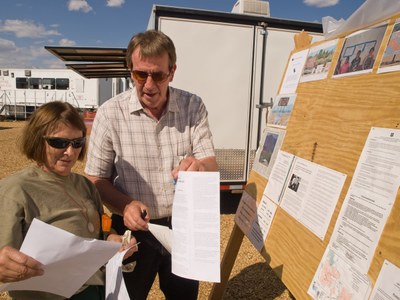
Assistance for individuals may be more limited than assistance to communities. In addition to these resources, you may find help from community volunteers and local organizations not included here, such as churches, community centers and local businesses. Local help can often mobilize quickly to provide services such as sheltering livestock or pets, providing household supplies to fire victims, and meeting other needs not met by the major agencies and organizations.
2022 Wildfire Information - New Mexico Department of Homeland Security
There are many current, helpful resources on this page including information and permits for the Full Service Debris Removal Program. This program allows all wildfire debris on residential properties within Mora and San Miguel Counties ro be collected, safely removed, and properly disposed of by the U.S. Environmental Protection Agency and the U.S. Army Corps of Engineers with no out of pocket costs to property owners.
U.S. Forest Service Claimants Helpdesk (877) 372-7248
 American Red Cross
American Red Cross
The American Red Cross responds to disasters 365 days a year and can assist impacted individuals with their immediate emergency needs. Call 1-800-RED CROSS (1-800-733-2767) and ask for your local chapter.
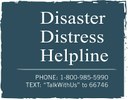 Disaster Distress Helpline
Disaster Distress Helpline
The Disaster Distress Helpline can assist you after a wildfire. Those impacted by recent wildfires can reach out to them any time for support. Call 1-800-985-5990, para español, oprima el dos, or text Text TalkWithUs to 66746 or Hablanos to 66746.
 Farm Service Agency: Assistance with Natural Disaster Loses
Farm Service Agency: Assistance with Natural Disaster Loses
The Farm Service Agency provides assistance for natural disaster losses, resulting from drought, flood, fire, freeze, tornadoes, pest infestation, and other calamities. For example, they provide assistance after a disaster to eligible livestock producers, honeybee producers, orchardists, forestland owners, tree nurseries and more. More information
 Food Assistance
Food Assistance
The SNAP (Supplemental Nutrition Assistance Program) may help you replace food lost in a disaster or help you apply for benefits. More information
 Help for Businesses and Non-Profits: Small Business Administration
Help for Businesses and Non-Profits: Small Business Administration
If your business or private, nonprofit organization has suffered physical damage or your small business or private, nonprofit organization of any size has sustained economic injury after a disaster, you may be eligible for financial assistance.
 Help for Renters and Homeowners: Small Business Administration
Help for Renters and Homeowners: Small Business Administration
The Small Business Administration provides low-interest disaster loans with long-term repayments to qualifying individuals and businesses.
 Helping Children Cope with Disaster
Helping Children Cope with Disaster
Disasters can be especially stressful for families with children. FEMA (the Federal Emergency Management Agency) and Sesame Street provide resources to assist you in helping children cope with disaster.
 New Mexico Burned Area Initiative: Natural Resources Conservation Service
New Mexico Burned Area Initiative: Natural Resources Conservation Service
The NRCS NM Burned Area Initiative is part of the their Environmental Quality Incentives Program (EQIP). The Burned Area Initiative is designed to help landowners restore conservation practices destroyed in fires or by off-site fire impacts. All EQIP programs have a continuous sign-up period.
 New Mexico Department of Homeland Security and Emergency Management
New Mexico Department of Homeland Security and Emergency Management
The NMDHSEM offers assistance to communities rather than at the individual level. However, individuals seeking advice after a wildfire can call the New Mexico Department of Homeland Security’s Public Information Officer at 505-476-0626 or the main line at 505-476-9600.
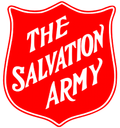 The Salvation Army
The Salvation Army
The Salvation Army may provide temporary assistance for families in need, including vouchers for rent and emergency aid and legal aid. For information on services provided by The Salvation Army, click here. For Salvation Army locations and phone numbers in New Mexico, click here.
Southern Baptist Disaster Relief
SBDR is a Christian organization that aims to meet the urgent needs of hurting humanity in crisis situations. They provide many different types of relief, including food, water, child care, laundry, repairs, rebuilding and more. For example, they provided direct assistance in New Mexico after destructive wildfires such as removing debris from burned home sites. Southern Baptist Disaster Relief has gained national and international recognition for service in crisis situations across the nation and the globe.
Self Help
Each year, through grants and private and public contributions, Self Help is able to support those who need help most during emergencies to the residents of Los Alamos, northern Santa Fe, Rio Arriba, and Taos counties. More information
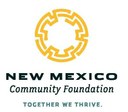 Vecino Fund
Vecino Fund
New Mexico Community Foundation’s Vecino Fund provides “neighbor helping neighbor” funds for individuals in times of crisis, including after a wildfire. While NMCF does not give money directly to individuals, it provides financial assistance to agencies and organizations to purchase needed supplies and services to then assist individuals. To learn more about the Vecino Fund call 505-820-6860.
 Water Quality and Safety: Private Well Testing
Water Quality and Safety: Private Well Testing
The New Mexico Environmental Department (NMED) provides free testing of private domestic wells to check for contamination after a wildfire.
2-1-1 Free Information and Referral Center
While 2-1-1 is not specific to post-wildfire situations, it is a regional free Information and Referral Center connecting residents to community resources located in their area. 2-1-1 has several regions in New Mexico.
Disaster Distress Helpline
The Disaster Distress Helpline can assist you after a wildfire. Those impacted by recent wildfires can reach out to them any time for support. Call 1-800-985-5990, or text Text TalkWithUs to 66746 or Hablanos to 66746.
Vecino Fund
While NMCF does not give money directly to individuals, it provides financial assistance to agencies and organizations to purchase needed supplies and services to then assist individuals.
Click here to learn more about the Vecino Fund, or call 505-820-6860.
New Mexico Department of Homeland Security and Emergency Management
The NMDHSEM offers assistance to communities rather than at the individual level. However, individuals seeking advice after a wildfire can call the New Mexico Department of Homeland Security’s Public Information Officer at 505-476-0626 or the main line at 505-476-9600.
Water Quality & Safety: Private Well Testing
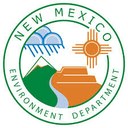
Visit the NMED Drinking Water Bureau website at http://www.nmenv.state.nm.us/dwb/index.htm for more information, or call 877-654-8720 Monday - Friday, 8-5, or contact Tom Skibiski at thomas.skibiski@state.nm.us or at 505-827-1758. Click here to find out more about this program and what to do about floodwater contaminated wells (which can occur after a wildfire, flooding or other emergency).
General Forest Restoration Assistance
What is it? The NM State Forestry Division can assist landowners in working with other governmental organizations to find and secure necessary tools and funding to stabilize and restore their burned properties and watersheds. This can include advisement, planning assistance, and project design to help the applicant find the resources needed to complete restoration and stabilization projects.
Who Can Apply? There are no dedicated funds for this program, but NM State Forestry can offer assistance to both individuals and communities. There is no timeline for application as assistance is available as per the scope of work of the Division (depending on staff resources and availability).
Are Matching Funds Required?: Yes, as NM Forestry has no dedicated funds for assistance.
When Can I Expect To Receive My Funds?: Technical assistance is always available as per scope of work of the Division, but deadlines depend on the program that best fits the applicant's goals and objectives. Timing varies.
Contact Name: Doug Boykin
Contact Phone Number: 575-835-9359 for Doug, or contact the main State Forestry Office in Santa Fe at 505-476-3325
Contact Email: doug.boykin@state.nm.us
Program Website: http://www.emnrd.state.nm.us/SFD/
American Red Cross
Help for Businesses and Nonprofits
What is it? If your business or non-profit organization – regardless of size –is located in the declared disaster area (the declaration may be either Presidential or a SBA administrative declaration; it is worth checking in with them), you may apply for a long-term, low-interest loan to repair or replace damaged property. Even if your property was not damaged and you are a small business owner or a private, nonprofit organization, you may apply for a working capital loan from the SBA to relieve the economic injury caused by the disaster. The SBA may refinance mortgages in some cases.
Who Can Apply? Businesses and nonprofits within the parameters explained in the paragraph above.
Are Matching Funds Required? No
When Can I Expect To Receive My Funds? The sooner you return the completed loan application, the sooner the SBA can process it. The SBA tries to make a decision within 18 days. Make sure the application is complete. Missing information is a major cause of delays.
Contact Phone Number: 800-659-2955
Contact Email: disastercustomerservice@sba.gov
Program Website: http://www.sba.gov/category/navigation-structure/loans-grants/small-business-loans/disaster-loans
Help for Renters and Homeowners
What is it? The SBA provides low-interest disaster loans with long-term repayments to qualifying individuals and businesses. If you are in a declared disaster area (the declaration may be either Presidential or a SBA administrative declaration; it is worth checking in with them) and are the victim of a disaster, you may be eligible for a low-interest rate disaster loan from the U.S. Small Business Administration. Renters and homeowners alike may borrow up to $40,000 to repair or replace clothing, furniture, cars or appliances destroyed during a disaster. Homeowners may apply for up to $200,000 to repair or replace their primary residence to pre-disaster condition.
Who Can Apply? Individuals in a declared disaster area that are the victim of a disaster are eligible to apply. The funds cannot be used for barns, crops, fencing etc; but just for the items described in the summary above. SBA can approve a loan for the total replacement cost up to their lending limits; you do not need to wait for an insurance settlement before applying. Once your insurance settles, if there is a duplication of benefits, we will apply those funds to the balance of your disaster loan.
Are Matching Funds Required?: No
When Can I Expect To Receive My Funds?: The SBA disaster assistance program helps with long-term, low-interest rebuilding and repair of damaged property, unlike immediate emergency relief provided by relief organizations. To make a loan, they must know the repair cost, be assured that you can repay the loan, and take reasonable safeguards to make sure the loan is repaid. The sooner you return the completed loan application, the sooner SBA can process the application. SBA tries to make a decision on each application within 14 days. Make sure the application is complete, since missing information is a major cause of delays.
Contact Phone Number: Disaster Loans: 800-659-2955
Contact Email: disastercustomerservice@sba.gov
Program Website: Visit website
The Salvation Army
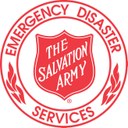
For information on services provided by The Salvation Army, click here. For Salvation Army locations and phone numbers in New Mexico, click here.
Self Help, Inc.

Self Help enhances life skills and empowers individuals by providing programs and services that focus on developing self-reliance. Self Help provides consultation and advocacy, emergency financial assistance and seed money grants to residents of Los Alamos, northern Santa Fe, Rio Arriba, and Taos counties. Each year, through grants and private and public contributions, Self Help is able to support those who need help most during emergencies. Click here to learn more or call 505-662-4666.
Helping Children Cope with Disaster

Visit www.fema.gov or get a copy of FEMA 478 Helping Children Cope with Disaster. To obtain this or other publications call the FEMA publications warehouse at 1-800-480-2520. You can also visit the Department of Homeland Securities’ www.ready.gov.http://www.fema.gov/coping-disaster#4.
You may also visit Sesame Street's Handling Emergencies.
Assistance with Natural Disaster Losses: Farm Service Agency

The Farm Service Agency’s Livestock Forage Program compensates eligible livestock producers who have suffered grazing losses due to fire and drought.
The Farm Service Agency’s Livestock Indemnity Program provides assistance to producers for livestock deaths that result from disaster.
The Farm Service Agency’s Emergency Assistance for Livestock, Honeybees and Farm-Raised Fish compensates producers for livestock losses from wildfire not adequately covered by any other disaster programs.
The Farm Service Agency’s Emergency Conservation Program provides emergency funding and technical assistance to rehabilitate farmland damaged by natural disasters.
The Farm Service Agency manages an Emergency Forest Restoration Program to help owners of non-industrial private forest land restore land damaged by wildfire.
Contact: For more information, visit the FSA website on disaster assistance here or call 505-761-4900. To find an FSA Service Center near you, click here.
Food Assistance

The Human Services Department will also help with applications for SNAP assistance. If you are not part of the SNAP program but need assistance, FEMA or Red Cross may be able to help in disaster declared areas, in addition to local food banks and pantries. You can also apply for SNAP benefits online. An expedited SNAP program exists to provide benefits within 7 days.
For more information, call 1-800-283-4465 or click here.
New Mexico Burned Area Initiative
The Environmental Quality Incentives Program (EQIP) provides financial and technical assistance to agricultural producers in order to address natural resource concerns and deliver environmental benefits such as improved water and air quality, conserved ground and surface water, reduced soil erosion and sedimentation or improved or created wildlife habitat.
Additional information is available here.
Contact: Please contact the District Conservationist in the USDA Service Center nearest the location of your property, or:
Kristin Graham Chavez
Assistant State Conservationist for Programs
505-761-4404
E-mail: kristin.grahamchavez@nm.usda.gov
2-1-1 Free Information and Referral Center

2-1-1 of Central New Mexico: United Way 2-1-1 provides free information and referrals to health and human services, government agencies, and community based organizations. United Way 2-1-1 is a comprehensive source for information, better connecting our community and increasing self-sufficiency. If you would like help finding resources, it’s easy! Dial Toll Free 2-1-1 or (505) 245-1735 to speak to a specialist. Calls answered 7 days a week, 8AM to Midnight, 365 days a year. Or access information in our online searchable database. See more at: http://www.uwcnm.org/211#sthash.ocDQiYJQ.dpuf
2-1-1 of Eastern New Mexico: Are you facing difficult times and don’t know where to turn? Are you looking for help with everyday needs? Do you want to volunteer? Dialing 2-1-1 is your first step. 2-1-1 is a free, easy to remember number to dial for information about health and human service organizations in your community. By dialing 2-1-1, information is much easier to find.To find resources available to residents of Curry County and Roosevelt County, New Mexico, enter information about the person needing services. See more at: https://www.unitedwayenm.org/211-info-helpline.
2-1-1 of Northern New Mexico: This is northern New Mexico's free Information and Referral Center connecting residents to community resources located in their area. When callers dial 2-1-1, they are connected to a trained individual who, using compassion and skill, takes time to asses the caller’s specific needs. Individuals can also access 2-1-1 Northern New Mexico’s database of community resources via the internet at referweb.net/unnm anytime. 2-1-1 Northern New Mexico began taking calls in June 2012, and 2013 marked its first full year in business. This region serves six counties: Los Alamos, Rio Arriba, Santa Fe, Mora, Taos, and San Miguel.
For Emergency Shelter, Food and Other Necessities
American Red Cross

The American Red Cross responds to disasters 365 days a year to assist impacted individuals with their immediate emergency needs. Contact the Red Cross here. Call 1-800-RED CROSS (1-800-733-2767) and ask for your local chapter.
Food Assistance
The SNAP (Supplemental Nutrition Assistance Program) may help you replace food lost in a disaster or help you apply for benefits through the NM Human Service Department. You can apply for SNAP benefits online. An expedited SNAP program for disasters exists to provide benefits within 7 days. For more information, call 1-800-283-4465 or click here.
Community, Faith-Based and Volunteer Groups
Local Community and Faith Based Organizations and Volunteer Groups may also offer disaster relief services. Groups such as the County Disaster or Emergency Services Offices often coordinate services provided by local groups. Attend a local wildfire information community meeting or call local churches, community groups, etc. to find out more.
Additional Assistance
Visit our Who Can Help section for more opportunities for assistance.
Emotional Support and Wildfire
 Wildfires often lead to emotional distress in those that experience them. Survivors living in the impacted areas (including children and teens), loved ones of victims, first responders, and rescue and recovery workers are all at risk.
Wildfires often lead to emotional distress in those that experience them. Survivors living in the impacted areas (including children and teens), loved ones of victims, first responders, and rescue and recovery workers are all at risk.
Feelings such as overwhelming anxiety, constant worrying, trouble sleeping and other depression-like symptoms are common responses (before, during and after the event). Most people need additional support to cope and move forward on the path of recovery. (Text adapted from the Disaster Distress Helpline wildfire page).
Agora Crisis Center
Agora, based out of the University of New Mexico, is a place that anyone can call when they have something to say or just need someone to listen. You don't have to be in crisis, you can call to talk about good things, bad things, stress, anger, or loneliness. Call (505) 277-3013 or 866-HELP-1-NM (866-435-7166). Agora can also chat online with you.
Crisis Center of Northern New Mexico
Visit http://crisis-centers.com/contact_us/ or call 1 800-206-1656, a 24-hour crisis line.
New Mexico Crisis and Access Line
Visit http://www.nmcrisisline.com or call 1 (855) NMCRISIS (662-7474).
The Disaster Distress Helpline
The Disaster Distress Helpline provides year-round, 24/7 phone- and text-based crisis counseling to anyone who is experiencing emotional distress related to natural or man-made disasters within the U.S. and territories. Those impacted by recent wildfires and might be experiencing distress and having difficulty coping can reach out to them any time for support. Call 1-800-985-5990, or text Text TalkWithUs to 66746 or Hablanos to 66746.
Firefighters and First Responders
Firefighters, agency personnel, and first responders may use all of the resources above; however, there are also resources specific to these groups:
- First Responder 24-Hour Crisis Hotline, 1-888-731-3473 (FIRE)
- Firefighter Behavioral Health Alliance, www.ffbha.org
- National Fallen Firefighter Foundation, www.firehero.org
- Wildland Firefighter Foundation www.wffoundation.org provides help to families of firefighters killed in the line of duty and assists injured firefighters and their families.
- The Life Challenge Program, www.lifechallengeprogram.org, provides information about suicide awareness for firefighters.
- Quick Series Publishing, www.quickseries.com, 1-800-361-4653, provides pocket books and eGuides for fire fighters, EMS and more.
Other Resources for Emotional Support
- Helping children deal with disaster, visit www.fema.gov or get a copy of FEMA 478 Helping Children Cope with Disaster. To obtain this and other fact sheets and publications call the FEMA publications warehouse at 1-800-480-2520. You can also visit the Department of Homeland Securities’ www.ready.gov, or the National Child Traumatic Stress Network.
- New Mexico Suicide Prevention Coalition, 1-855-662-7474, www.nmsuicideprevention.org.
- ACROSS = Association of Christians Reaching Our in Service and Support www.acrossweb.us.
Emotional Phases of Disaster
People may experience an emotional "high" after a disaster, due to survival and communities coming together. The emotional "lows" may come later, and be triggered months or years after the event. For a chart and an interesting article on this, please visit the OperationSAFE website here.
Caring For Your Pets and Livestock After Wildfire
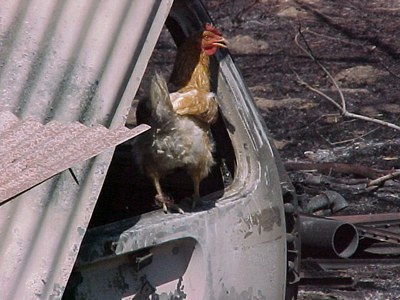 In addition to affecting your health and safety, wildfire also poses a threat to pets and livestock. Unfortunately disasters can mean that animals are left behind. This section offers some resources and precautions related to pets and livestock. See our Immediate Safety section for general safety information.
In addition to affecting your health and safety, wildfire also poses a threat to pets and livestock. Unfortunately disasters can mean that animals are left behind. This section offers some resources and precautions related to pets and livestock. See our Immediate Safety section for general safety information.
Pets
-
The accepted sequence for safety and evacuation is people first, then pets, then livestock, and then property. The same can be said of disaster recovery.
-
First and foremost: Stay away from your home or business until fire officials tell you it is safe to return.
-
Make sure your pet has some kind of identification, ideally a collar with a tag that has your contact information on it. Microchips also help; make sure you have at least one non-local contact person listed on your pet's chip registration in case local phones are out.
-
Whenever possible, do not leave animals behind. They can be lost, injured or killed.
-
Human evacuation shelters generally do not allow pets except for service animals.
-
Pet evacuation shelters are often available. To find out more about the location of shelters and other services available to pet owners, call Animal Protection of New Mexico at 505-265-2322 Ext. 29.
Livestock
-
The health and safety of livestock is primarily the responsibility of the owner.
-
Evacuation centers for livestock are usually located at country fairgrounds. Call your county emergency manager or the livestock board to find out more about these facilities.
-
Adrenaline, panic and confusion affect both humans and animals, so be aware of these effects.
-
Use caution when working with livestock after a wildfire. Their survival instincts can make normal handling techniques ineffective. Livestock are very sensitive to wildfire and will respond to a fire that is anywhere within their sensory range. Normal reactions range from nervousness to panic to aggressive escape attempts.
-
Livestock are often injured or killed by fleeing from a wildfire into fences and barriers. Be sure to check your animals for injuries from fences and to check your fences for damage from fleeing animals.
-
Report location, identification and disposition of your livestock to the authorities responding to the fire, especially if your animals are aggressive.
-
After you have been allowed to return to your property, it is important to locate your livestock and ensure they have access to high-quality forage with a protein and mineral supplement and good water. If livestock do not get adequate nutrition, their condition can deteriorate rapidly.
-
Check surviving livestock for signs of injury. Health disorders such as burned eyes, burned areas, and lung inflammation and edema from smoke inhalation are common after livestock experience wildfire. Have your livestock inspected by a vet as soon as possible. It can take a while for symptoms to appear, so monitor your cattle for several weeks after the fire.
-
After wildfire, be sure your livestock are pastured somewhere safe from flash floods and post-fire flooding, if possible.
-
Livestock have a natural instinct to move away from flash flood waters, and will generally seek higher ground if they can. Livestock will initially panic during flash floods and will fight fences if they are impeding their movement away from floodwaters. Be sure your pasture is fenced in a way that maximizes access to high ground to minimize injury and death.
-
The New Mexico Livestock Board and its partners assist in evacuations and work to make sure any livestock that had to be evacuated during a fire are claimed by their owners.
-
In the event of livestock fatalities, contact the State Livestock Board at 505-841-6161 to find out about disposal methods.
-
For additional information on assistance offered by the Livestock Board, call 505-841-6161.
-
The State Veterinarian, Ellen Wilson, DVM, can be reached at 505-841-6161 or through email at Ellen.Wilson@state.nm.us.
Financial and Funding Tips
After experiencing a destructive wildfire there are many financial implications for impacted communities and individuals. What if I lost my home or business to wildfire? What do I need to consider when applying for funds for my community? This section provides tips about finances and funding in a post-wildfire situation.
For Individuals, Families and Businesses: 'Financial Tips for Individuals'
For Communities: 'Funding 101 for Communities'
Key Items When Considering Funding Options: These tips help you decide which funding sources to apply for.
Make the most of volunteer and in-kind donations. Learn more here.
Tips for Individuals
 Experiencing a destructive wildfire can be financially straining, and even, in some cases, devastating. Below are some tips to assist individuals, families and businesses at this difficult time.
Experiencing a destructive wildfire can be financially straining, and even, in some cases, devastating. Below are some tips to assist individuals, families and businesses at this difficult time.-
Document, document, document: Take pictures of your property (and provide ‘before’ images if they are available). Photograph all damage from multiple angles. This will help with insurance claims and applications for assistance programs. Taking pictures is one of the single most important things you can do to help yourself.
-
Keep all of your receipts from restoration and recovery projects.
-
If you have insurance, contact your insurance agent as soon as possible. The Insurance Information Institute provides answers to Frequently Asked Questions about wildfire and insurance here. A brochure on 'Wildfire and Insurance' can also help you plan ahead.
-
Look into flood insurance: A top priority after a wildfire is flood preparedness; it is important to purchase flood insurance if at all possible. To find out more about flood insurance, go to www.floodsmart.gov.
-
Contact your lenders as soon as possible if your financial obligations cannot be met due to wildfire. For example, if you cannot pay your mortgage, you have more options if you work with your lenders sooner rather than later.
-
Do not assume FEMA (the Federal Emergency Management Agency) is all you need. A Presidential Disaster Declaration must be established in order for a community to become eligible for FEMA funding. Ensure your expectations of FEMA are realistic. FEMA does not replace homes or businesses (except in extremely rare cases). FEMA assistance, when provided, is not a substitute for insurance but rather will provide minimum assistance to get people on their feet after a disaster.
-
Look into tax relief programs: If a major disaster is declared, individuals who suffer losses may complete a retroactive tax return and take the loss out of the previous year’s return. This may provide some immediate funding for you in a post wildfire situation. An accountant or your local IRS office can help you navigate this process.
-
Contact your County Emergency Manager: Your local Emergency Manager needs to know how many damaged or destroyed homes and structures (particularly uninsured) resulted from the disaster, and how many businesses suffered impact. This will help them see if your community qualifies for disaster assistance, which in turn may help you receive additional help. For a list of County Emergency Managers, click here.
-
If you have irreplaceable and invaluable items, get them out of harm’s way. Even if the wildfire is over, flooding may be a very real risk. However, it is critical to not return home until you have been informed it is safe to do so. Lives should always come before material items.
-
For information on organizations and grant programs that may assist in a post wildfire situation, click here.
-
The Small Business Administration provides disaster loans for qualifying renters, homeowners, businesses and non-profits impacted by wildfire in a declared disaster area.
-
If you are part of the SNAP (Supplemental Nutrition Assistance Program), you may qualify to get additional food assistance in a wildfire situation. Call 1-800-283-4465 or click here.
-
While some help exists, there are gaps between what is available and the needs individuals may have after a wildfire. Keep realistic expectations.
-
If you are reading this before a wildfire occurs, use this as a resource to plan ahead: Many planning resources are available from the Federal Emergency Management Agency, New Mexico State Forestry, the Centers for Disease Control, and many others. Additionally, keep records and photos of your property stored in an off-site location (such as a safe deposit box), which can assist in keeping them safe for insurance and other claims.
Funding 101 for Communities
 After a wildfire, one of the most important tasks in community response is identifying and applying for disaster assistance. This section describes key items to consider when evaluating funding sources and preparing to apply for assistance for your community.
After a wildfire, one of the most important tasks in community response is identifying and applying for disaster assistance. This section describes key items to consider when evaluating funding sources and preparing to apply for assistance for your community.
-
Fund Immediate Threats: After wildfire, you need to immediately assess the threat that flash flooding poses. You may have limited time between when the fire is controlled enough to allow for mitigation work to begin and when the rains will come. Unfortunately, many of the sources of funding to help pay for mitigation projects: 1) do not pay for projects that have already been started or completed; and 2) provide funding on a time frame that takes weeks and months, rather than the hours and days when project implementation can make significant differences.
-
Your first task is to identify what funds are available in the community for immediate use, and to prioritize projects that will provide the most expedient protection. It is better to spend that money quickly and wisely and get some immediate protection, than to hold the funds to match future federal contracts and have more damage to contend with because preventative measures were not implemented in a timely manner. Be sure to handle these actions as separate projects that do not jeopardize your community’s opportunities to compete for federal funding for other projects.
Key Items When Considering Funding Options
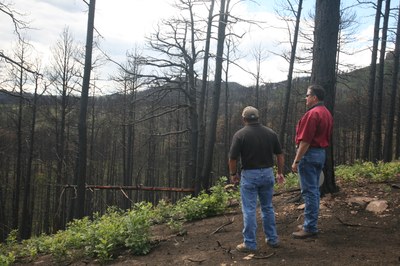 Fundraising after a wildfire can be confusing and time consuming. Below are key points to consider when deciding which funding opportunities to apply for. For information on funding sources, visit 'Who Can Help'.
Fundraising after a wildfire can be confusing and time consuming. Below are key points to consider when deciding which funding opportunities to apply for. For information on funding sources, visit 'Who Can Help'.
- Evaluate timelines for applying: Does it make sense for you or your community to apply given deadlines? What is due when? Is your community prepared to meet the requirements of the grant in the time required?
- Timeline of funding availability: You might be able to apply today, but when will the funding be made available to you? How much money will you or your community need to spend before being reimbursed, and where will it come from? Funds from grants may take a year or more to arrive, or are available on a reimbursement-only basis. Even if a funding source is labeled ‘emergency’ funding, it may take a long time to become available. Before you spend a lot of time on an application, make sure the timeline for funding distribution works for your situation.
-
Recordkeeping requirements: Make sure you know the recordkeeping requirements for each funding source, such as compliance reports, accounting and audit obligations, photos, and receipts. Can you or your community meet these requirements? Demonstrating that you can follow these requirements is crucial for a successful application, for receiving funding, and for financial compliance. Additionally, you must follow federal and state procurement guidelines for government grants or your funding may be taken back.
-
Funding Restrictions: Make sure that receiving funding from one resource does not limit other important options. Different funding programs have different rules (e.g. one program may require a 25% local match, another a 50% local match.) Ask lots of questions. For example, receiving some federal funding may disqualify you for other federal grants. The New Mexico Department of Homeland Security’s Hazard Mitigation Unified Guidance describes the rules and restrictions for FEMA disaster mitigation grants. Click here for contact information for the hazard mitigation officer who can help familiarize you with the requirements for FEMA funding.
Make the Most of Volunteers and In-Kind Donations
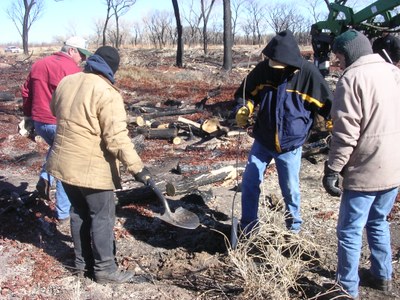 In-kind work and donations often count as match for funding, but will need to be carefully documented. Most “match” must be an approved part of a grant agreement. Scrutinize the match eligibility and documentation requirements for each type of grant. Do not assume that any particular activity can be counted as match for a particular funding stream, but do keep track of everything that your staff and volunteers and others in the community are doing. Grantors are generally willing to work closely with local governments to identify match opportunities, but have to meet their own programmatic requirements.
In-kind work and donations often count as match for funding, but will need to be carefully documented. Most “match” must be an approved part of a grant agreement. Scrutinize the match eligibility and documentation requirements for each type of grant. Do not assume that any particular activity can be counted as match for a particular funding stream, but do keep track of everything that your staff and volunteers and others in the community are doing. Grantors are generally willing to work closely with local governments to identify match opportunities, but have to meet their own programmatic requirements.
Flood Information
 |
|---|
| Mogollon Flood, September 2013. Credit: US Forest Service |
What is a Flood?
A flash flood is a rapid increase in flow along a stream channel that may allow the water to overflow channel banks and cause a flood. Typically during monsoon season (July through September) there is very little time between the storm event upstream and the arrival of the flood downstream, often under an hour. If this flood contains rocks, trees and other debris, it is termed a debris flow.
The National Weather Service provides information on the potential for rainstorms causing flooding in your area. They have a three-tier warning system to alert citizens of the threat posed by developing weather systems:
- Flood Watch: Flooding is possible. Conditions are favorable for flooding but flooding is not definite.
- Flood Warning: Flooding is occurring or will occur soon; if advised to evacuate, do so immediately.
- Flash Flood Warning: A flash flood is occurring; seek higher ground on foot immediately.
For more information, visit www.floodsmart.gov
Floods Following Wildfire
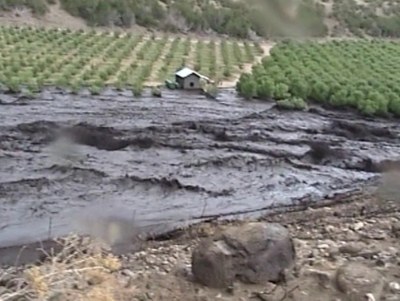 |
|---|
| Dixon’s Apple Orchard Cochiti Canyon Flood August 22, 2011 Credit: Phoebe Suina, Pueblo of Cochiti |
Wildfires dramatically change landscape and ground conditions, which can lead to increased risk of flooding during heavy rains because the burned ground is unable to absorb the falling rain, producing runoff conditions much like a parking lot. Because of this, even modest rainstorms over a burned area can result in flash flooding downstream. These floods are typically much larger for a given sized storm than they were before the wildfire, so flooding is likely to be much more extensive following wildfire, endangering properties previously considered safe from flooding. These floodwaters typically transport surface debris such as downed trees, boulders, and gravel.
Many areas in New Mexico are at an increased flood risk due to wildfires in recent years. Residents and businesses in areas downstream of a wildfire need to be aware of the hazards they face, the steps they can take to reduce their risk, and resources that may be available to assist them.
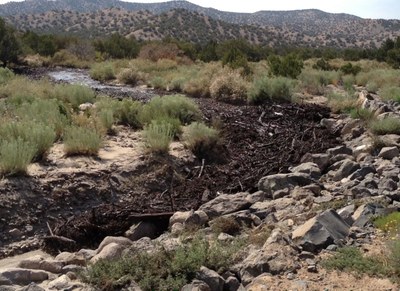 |
|---|
| Debris Flow in Peralta Canyon August 19, 2012 Credit: Ryan Weiss |
Post-Fire Floods and Debris Flows
In New Mexico, the biggest threat from wildfire, both in terms of life-safety and damages, comes from post-fire flooding. This flooding typically occurs during the summer and early fall associated with thunderstorms that develop during monsoon season. These storms are typically very local, very intense, and of short duration, delivering a lot of rain in a short amount of time. When such storms develop over burned areas, the ground cannot absorb the rain. The precipitation runs off the burned area, and accumulates in streams, producing a flash flood.
Before a Flood
 A top priority for flood preparedness is to purchase flood insurance. To find out more about flood insurance, go to www.floodsmart.gov. For other financial tips related to wildfire, click here.
A top priority for flood preparedness is to purchase flood insurance. To find out more about flood insurance, go to www.floodsmart.gov. For other financial tips related to wildfire, click here.
If your property is located in an area in danger of post-fire flooding, remove hazardous materials such as chemicals from your home and outbuildings. You may move the hazardous materials to a location that is not in danger of flooding, or for information on disposal locations, click here, or contact the New Mexico Environment Department.
- For techniques to help address flood hazard, see our Post Fire Treatments section. For information on funding resources related to flooding, visit our Who Can Help page for community assistance and look for resources provided by the US Army Corps of Engineers.
- USGS has a new process for predicting debris flows more quickly; they also may install real-time early warning rain gauges for communities affected by wildfire. Contact the New Mexico USGS Water Science Center to find out more.
- For past USGS studies on debris flow hazards from New Mexico wildfires (Whitewater-Baldy, Las Conchas and Track fires), click here. This includes areas that are most likely to have the greatest debris flows, and may be helpful to areas also anticipating debris flows.
Before the Flood Checklists
Family Plan
- Identify the types of hazards that could affect your family. Know your home’s vulnerability to storm surge, flooding, and wind.
- Locate a safe room or the safest areas in your home for each hazard. In certain circumstances, the safest areas may not be in your home but within your community.
- Determine escape routes from your home and places to meet. These should be measured in tens of miles rather than hundreds of miles.
- Have an out-of-state friend as a family contact so all your family members have a single point of contact.
- Make a plan now for what to do with your pets should you need to evacuate.
- Post emergency telephone numbers by your phones and make sure your children know how and when to call 911.
- Check your insurance coverage. Flood damage is not usually covered by homeowners insurance.
- Stock non-perishable emergency supplies and a Disaster Supply Kit.
- Use a NOAA weather radio. Remember to replace its batteries every 6 months, as you do with your smoke detectors.
- Take First Aid, CPR, and disaster preparedness classes.
Supply Kit Checklist
- Water—at least 1 gallon daily per person for 3 to 7 days
- Food—at least enough for 3 to 7 days
- non-perishable packaged or canned food and juices
- food for infants or the elderly
- snack foods
- non-electric can opener
- cooking tools and fuel
- paper plates and plastic utensils
- Blankets, pillows, etc.
- Clothing—seasonal, rain gear, sturdy shoes, etc.
- First aid kit, medicines, and prescription drugs
- Special items for babies and the elderly
- Toiletries, hygiene items, and moisture wipes
- Flashlight
- Batteries
- Battery-operated NOAA weather radio
- Fully charged cell phone with extra battery and a traditional (not cordless) telephone set
- Cash (with some small bills) and credit cards—banks and ATMs may not be available for extended periods
- Keys
- Toys, books, and games
- Important documents in a waterproof container or watertight, re-sealable plastic bag insurance
- Medical records, bank account numbers, Social Security card, etc.
- Tools
- Full vehicle fuel tanks
- Pet care items
- proper identification, immunization records, and medications
- ample supply of food and water
- a carrier or cage
- muzzle and leash
Insure Your Property Against Floods
Did you know, insurance typically does not cover flooding? Homes and business located in flood areas need to purchase flood insurance to cover damages caused by flooding. Because post-wildfire floods are typically more extensive than before wildfires, individuals and businesses downstream of wildfires need to reassess their flood risk and reevaluate the need for purchase flood insurance even if previously they were outside the flood zone.
To find out more about flood insurance, go to www.floodsmart.gov.
For other financial tips related to wildfire, click here.
FEMA has published almost 100,000 individual Flood Insurance Rate Maps (FIRMs). See your map and learn how to read it so you can make informed decisions about protecting your property, both financially and structurally.
Actions That You Can Take Before a Flood Occurs
After getting flood insurance, there are several things you can do to minimize losses in your home or business and ensure the safety of family and employees.
1. Safeguard your possessions.
Create a file containing information about all your property and its contents, and keep it in a secure place, such as a safe deposit box or waterproof container. This file should have:
- A copy of your insurance policies with your agent’s contact information.
- An inventory: For insurance purposes, be sure to keep a written and visual (i.e., videotaped or photographed) record of all major items and valuables, even those stored in basements, attics or garages. For more information visit www.knowyourstuff.org.
- Copies of all other critical documents, including finance records or receipts of major purchases.
- Businesses should have a plan for resuming operations after a flood.
2. Prepare your property.
- First make sure your sump pump is working and then install a battery-operated backup, in case of a power failure. Installing a water alarm will also let you know if water is accumulating in your basement.
- Clear debris from gutters and downspouts.
- Anchor any fuel tanks.
- Raise electrical components (switches, sockets, circuit breakers, and wiring) at least 12 inches above your homes projected flood elevation.
- Place the furnace, water heater, washer, and dryer on cement blocks at least 12 inches above the projected flood elevation.
- Move furniture, valuables, and important documents to a safe place.
- If your property is located in an area in danger of post-fire flooding, remove hazardous materials such as chemicals from your home and outbuildings. You may move the hazardous materials to a location that is not in danger of flooding, or for information on disposal locations, click here, or contact the New Mexico Environment Department.
- Protect areas susceptible to floodwaters by placing sandbags. Sandbags can be used to keep water out of buildings, to redirect floodwaters away from property, or to fill in damaged spots in berms or levees. Sandbags are prepared in the following manner:
- Filling sandbags is a two person job. Have one person crouch or kneel, holding the bag upright on the ground. The second person shovels sand into the bag until the bag is one-half to two-thirds full. Fold the top of the bag over; do not tie bags. Sandbags are generally filled near the location where they will be placed.
- Place the bag in the desired location such that the open end of the bag is folded under the sand.
- Bags can be stacked up to three-high a single line or can be stacked in a pyramid shape, with each layer containing one row fewer than the layer below. The pyramid pattern provides more stability, but requires more bags.
- Alternate the placement of the bags to fill in potential gaps or weak spots.
- Place sandbags with the folded end of the bag facing the upstream direction from which the water will flowing. This will cause the water to keep the bag sealed, rather than opening the bag and spilling the contents.
For more details on sandbagging techniques, click here.
3. Develop an emergency plan.
- Create a safety kit with drinking water, canned food, first aid, blankets, a radio, and a flashlight.
- Post emergency telephone numbers by the phone and teach your children how to dial 911.
- Plan and practice a flood evacuation route with your family or employees. Know safe routes from home, work, and school that are on higher ground.
- Ask an out-of-state relative or friend to be your emergency contact.
- Have a plan to protect your pets.
- Itemize and take pictures of possessions and assets.
Keep valuable items on the upper floors of your home or building.
During a Flood

Flash Flooding in Alamogordo, June 2006 |
|---|
- Do not walk through moving water. Six inches of moving water can make you fall. If you have to walk in water, walk where the water is not moving. Use a stick to check the firmness of the ground in front of you.
- Do not drive into flooded areas. If floodwaters rise around your car, abandon the car and move to higher ground if you can do so safely. You and the vehicle can be quickly swept away. It can take only a foot or two of water to float or sweep away your vehicle.
- NOAA Weather Radio: Listen to NOAA Weather Radio for information on flooding and other weather alerts.
- Be aware of streams, drainage channels, canyons, and other low-lying areas that can flood suddenly. Flash floods can occur in these areas with or without such typical warnings as rain clouds or heavy rain.
- If there is any possibility of a flash flood, move immediately to higher ground. Do not wait for instructions to move.
- Do not attempt to walk across flowing streams or drive through flooded roadways.
- If water rises in your home before you evacuate, go to the top floor, attic, or roof.
- Listen to a battery-operated radio for the latest storm information.
- Turn off all utilities at the main power switch and close the main gas valve if advised to do so.
- If you've come in contact with floodwaters, wash your hands with soap and disinfected water.
- If it is safe to evacuate, leave your home.
- Secure your home. If you have time, bring in outdoor furniture.
- Turn off utilities at the main switches or valves if instructed to do so. Disconnect electrical appliances. Do not touch electrical equipment if you are wet or standing in water.
For more information visit www.floodsmart.gov
If You Must Prepare to Evacuate
Secure your home. If you have time, bring in outdoor furniture. Move essential items to an upper floor.
Turn off utilities at the main switches or valves if instructed to do so. Disconnect electrical appliances. Do not touch electrical equipment if you are wet or standing in water.
If You Have to Leave Your Home
Do not walk through moving water. Six inches of moving water can make you fall. If you have to walk in water, walk where the water is not moving. Use a stick to check the firmness of the ground in front of you.
Do not drive into flooded areas. If floodwaters rise around your car, abandon the car and move to higher ground if you can do so safely. You and the vehicle can be quickly swept away. It can take only a foot or two of water to float or sweep away your vehicle.
NOAA Weather Radio: Listen to NOAA Weather Radio for information on flooding and other weather alerts.
After a Flood
- Listen to NOAA weather radio, a battery-operated radio, or television for the latest emergency information. Use phones only for emergency calls. Stay away from damaged areas. Return home only when authorities say it is safe.
- As soon as floodwater levels have dropped, it's time to start the recovery process. Here's what you can do to begin restoring your home.
- If your home has suffered damage, call your insurance agent to file a claim.
- Check for structural damage before re-entering your home to avoid being trapped in a building collapse.
- Take photos of any floodwater in your home and save any damaged personal property.
- Make a list of damaged or lost items and include their purchase date and value with receipts, and place with the inventory you took prior to the flood. Some damaged items may require disposal, so keep photographs of these items.
- Keep power off until an electrician has inspected your system for safety.
- Boil water for drinking and food preparation until authorities tell you that your water supply is safe.
- Prevent mold by removing wet contents immediately.
- Wear gloves and boots to clean and disinfect. Wet items should be cleaned with a pine-oil cleanser and bleach, completely dried, and monitored for several days for any fungal growth and odors.
If additional assistance is needed, contact your county Emergency Manager.
Additional Resources
Highlighted Resources
There are many additional resources for communities and individuals beyond this guide. Below are a few featured resources.
- Preparing for After the Fire is a powerful short movie to help communities think ahead about wildfire response created by the Chumstick Wildfire Stewardship Coalition in WA. Use this discussion guide along with the video.
Preparing for After the Fire from Hilary Lundgren on Vimeo.
- Wildfire Season in New Mexico is an easy-to-use, condensed brochure of useful information before, after, and during a wildfire. It also contains information on defensible space for your home.
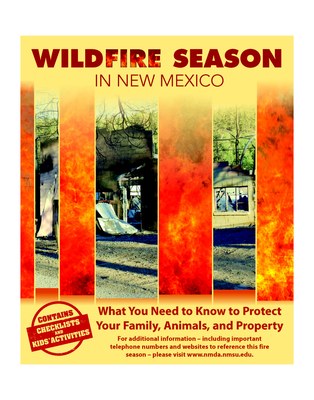
- 'After the Fire' Toolkit provides ready-made communication tools for your community after a wildfire.
- Recovers.org is a tool to help communities match volunteers to needs after a disaster. They also offer an inspiring TED talk about community response to disasters.
- Team Rubicon unites the skills and experiences of military veterans with first responders to rapidly deploy emergency response teams to disasters such as wildfires.
- There's An App for That: Apps for disaster response to upload to your smartphone now.
- Wildfire Planning resources to prepare before a wildfire occurs.
Immediate Needs
For information on food and shelter, click here.
For information on who can help individuals and families, click here.
For information on helping children deal with disaster, visit www.fema.gov or get a copy of FEMA 478 Helping Children Cope with Disaster here. You may also call the FEMA publications warehouse at 1-800-480-2520 to obtain this and other publications. More information is available at the Department of Homeland Securities’ www.ready.gov. You may also visit Sesame Street's Helping Children Understand Natural Disasters.
The Disaster Distress Helpline
The Disaster Distress Helpline is free and confidential, and helps with emotional distress after a disaster, 1-800-985-5990.
The link address is: http://disasterdistress.samhsa.gov/
Apps
Here are some apps for mobile devices that may be useful after a wildfire or other natural disaster.
- The FEMA Mobile App helps you plan for and respond to natural disasters.
- The First Aid App from the American Red Cross may help in response to natural disasters.
- ReUnite helps connect lost family members and friends in a disaster situation.
- Wildfire from the American Red Cross provides wildfire news and updates, and helps you prepare and respond.
- Weather Underground
- Dark Sky weather information ($3.99)
Wildfire Planning
Wildfire Planning Resources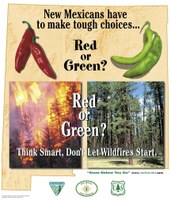
- Small Steps Can Save Homes, Communities: This 2014 article from National Geographic outlines small steps that you can do to help protect your home.
- Living with Fire: A Guide for the Homeowner - New Mexico: Short guide to help New Mexicans learn how to live more safely with the threat of wildfire (see the Spanish version here).
- Viviendo Con Incendios: Una Guía para los Dueños de casas en Nuevo México (en Español): Una guía para enseñarles a las personas cómo vivir más seguros con la amenaza de un incendio forestal.
- Community Wildfire Protection Plans from New Mexico State Forestry: Community Wildfire Protection Plans (CWPP's) have three main components: (1) Collaboration with all stakeholders throughout the CWPP process, (2) Identification and prioritization of hazardous fuel reduction areas and (3) addressing the treatment of structural ignitability within the CWPP area.
- Fire Adapted Communities provides a 'go-to' reference document, the 'Guide to Fire Adapted Communities' wildfire preparedness. It offers actions you and your community can take to become more fire adapted. It also includes recent case studies and outlines considerations to take to increase awareness and affect change in local wildfire preparedness understanding, and includes outreach and collaboration guidance.
- New Mexico's Department of Homeland Security and Emergency Management's (NMDHSEM) Hazard Mitigation Site: The Mitigation Unit can help you access your community hazard mitigation plan, develop a plan for your community and find FEMA mitigation program guidance.
- Tribal Hazard Mitigation Planning Guide from FEMA : This guide will assist Indian Pueblo and Tribal governments assess their risk and create a plan to protect their members and resources.
- Local Mitigation Planning Handbook from FEMA: The Local Mitigation Planning Handbook (Handbook) is the official guide for local governments to develop, update and implement local mitigation plans.
- Wildfire Preparedness and Planning at Ready.gov: Learn what protective measures to take before, during and after a wildfire.
- Firewise Communities: Find out what experts know about the best ways to make your home and neighborhood safer from a wildfire.
- A Guide to Staying Safe During Wildfires: This all-in-one guide delivers the essential strategies and tactics to keep you safe from wildfire — no matter where you live.
- Western Oregon University CERT Resources: CERT is about readiness, people helping people, rescuer safety...
- Colorado State University Extension Fire Resources: The most up-to-date fire-related resources, from CSU Extension and our partnering agencies.
-
Driftless Prairies: Native Ecosystems-The Interaction of Fire and Grass: Understanding the biology and physiology of grass in management decisions
Wildfire Recovery Guides from Other Sources
The After the Fire Toolkit was designed to allow community coalitions, local wildfire coordinating groups, fire districts and other wildfire organizations to respond to post-fire community needs quickly, accurately, and comprehensively. It includes items such as templates for Public Service Announcements, doorhangers and more.
The Phoenix Guide
The Phoenix Guide is a handbook for watershed and community wildland fire recovery, and provides information on the impacts of wildfire, community engagement, the recovery process, restoring landscapes, volunteer liability, and grants.
Community Wildfire Desk Guide & Toolkit
This is a good, condensed comprehensive resource for communities developed by the National Association of Conservation Districts. It includes post-wildfire information such as obtaining and delivering assistance, revitalizing the local community, and identifying threats of flooding.
Recovering From Wildfire: A Guide for Arizona’s Forest Owners
This guide from Arizona Cooperative Extension focuses on resource damages, erosion control measures, and assessing tree damage.
Burned Area Rehabilitation Guide from the Natural Resources Conservation Service in New Mexico.
Social Networking Resources
Social media is an opportunity to get timely updates related to wildfire in New Mexico, and to learn more about resources that are available.
 Sign up for New Mexico State Forestry's free wildfire email alert service.
Sign up for New Mexico State Forestry's free wildfire email alert service.
 Twitter:
Twitter:
- Weather: @NWSAlbuquerque
- Southwest Coordination Center provides updates on almost every fire, big and small, in New Mexico: @SWCCNewsNotes
- NM Emergency Management: @NMDHSEM
- NM State Forestry: @NMStateForestry
- NM Fire Info: @NMFireInfo
- Information on National Forests: @USFSSouthwest; @SantaFeNF; @CarsonNF; @CIBOLA_NF; @LincolnUSForest; @gilanforest
 Facebook
Facebook
- New Mexico State Forestry
- Sesame Street's Helping Children Understand Natural Disasters
- InciWeb, an interagency all-risk incidient web information management system provided by the US Forest Service
- NM Fire Info
- United States Wildfire Emergency Alerts
- National Interagency Fire Center
- USDA Forest Service
- Bureau of Land Management, New Mexico
- American Red Cross New Mexico
Toolkit Outreach Materials
Outreach materials area already designed – all you have to do is enter your contact information, change the resources to be appropriate for your community, and start getting the word out.
Within this toolkit you will find the following:
- Doorhanger (PDF, door hanger_back, door hanger_back customizable, door hanger_front)
- Be Prepared Public Service Announcement (Microsoft Word, Know Your Risks PSA) 30 and 60 seconds
- Resilience Public Service Announcement (Microsoft Word, Resilience PSA) 30 and 60 seconds
- Press Release (Microsoft Word, Press Release)
- Brochure, Action-focused
- What You Need to Know: Weather and Flooding one-pager (PDF, NOAA Radio reduced file size, NOAA Radio (300 dpi))
- Business Resilience one-pager (Microsoft Word and PDF, Business resilience 1 pager, Business resilience 1 pager customizable)
- Facebook/Twitter posts (Microsoft Word Twitter_Template)
All of the above resources are designed to be customizable for your community. No special software or printing capability is needed. Any computer capable of opening, editing and printing a Microsoft Word and/or PDF file is able to utilize the materials within the toolkit.
The Toolkit was put together by the Chumstick Coalition, a member of the Fire Adapted Communities Learning Network. For questions regarding the After the Fire toolkit, please email director@chumstickcoalition.org.
USGS New Mexico Debris Flow Hazard Studies
Want to learn more about post-wildfire flooding? U.S Geological Survey has produced three reports modeling post-fire debris flows. The reports include information such as the areas of the highest probability of the largest debris flows during flooding some recent New Mexico wildfires. You can see the completed reports at the links below. Also, USGS may help communities before or after a wildfire, including early warning rain and stream gauges and debris-flow modeling.
|
For more information, call (505) 830-7905 or visit the USGS Water Resources of New Mexico site here. |
http://pubs.usgs.gov/of/2012/1188/ofr2012-1188.pdf (Whitewater-Baldy)
http://pubs.usgs.gov/of/2011/1308/ (Las Conchas)
http://pubs.usgs.gov/of/2011/1257/ (Track Fire)
Guide Contributors
This effort was led by New Mexico State Forestry, with funding and input provided by the USDA Forest Service. We would like to extend special thanks to the following individuals, agencies and organizations who helped us develop this guide: USDA Natural Resources Conservation Service, New Mexico Association of Counties, New Mexico Forest and Watershed Health Coordinating Group, New Mexico State University, and the US Army Corps of Engineers. A special thanks to Madeleine Carey and Ryan Weiss for their work on the guide, and to the Forest and Watershed Restoration Institute for hosting this website.
Other contributors also helped by providing information and feedback, including the New Mexico Department of Homeland Security and Emergency Management.
 New Mexico Association of Counties
New Mexico Association of Counties
NM Association of Counties
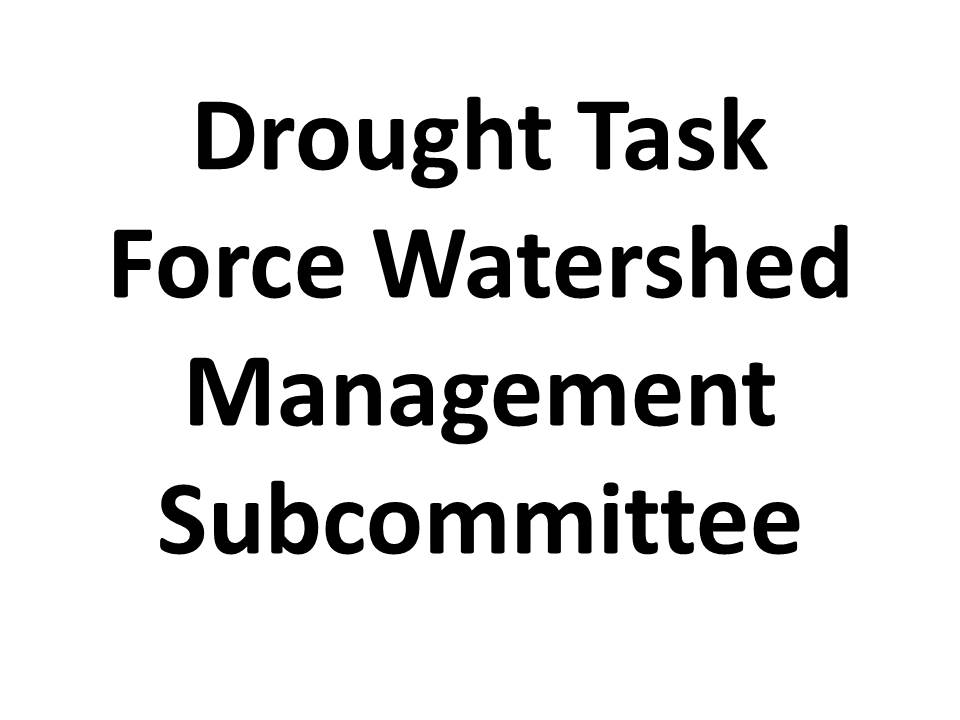 Drought Task Force Watershed Management Subcommittee
Drought Task Force Watershed Management Subcommittee
The Watershed Subcommittee is a broad-based, action oriented collaborative group that coordinates watershed management in New Mexico. Member entities help implement action items in the New Mexico Forest and Watershed Health Plan and the State Forest Action Plan. Members represent twenty agencies, non-governmental organizations and the private sector, including: Bureau of Indian Affairs, Bureau of Land Management, Bureau of Reclamation, New Mexico State Forestry Division, Interstate Stream Commission, Natural Resources Conservation Service, New Mexico Association of Conservation Districts, New Mexico Coalition of Conservation Districts, New Mexico Department of Agriculture, New Mexico Department of Game and Fish, New Mexico Environment Department, New Mexico Forest and Watershed Restoration Institute, New Mexico Forest Industry Association, New Mexico State University, NMSU Mora Research Center, Office of the State Engineer, Range Improvement Task Force, State Land Office, The Nature Conservancy, US Fish and Wildlife Service and US Forest Service.
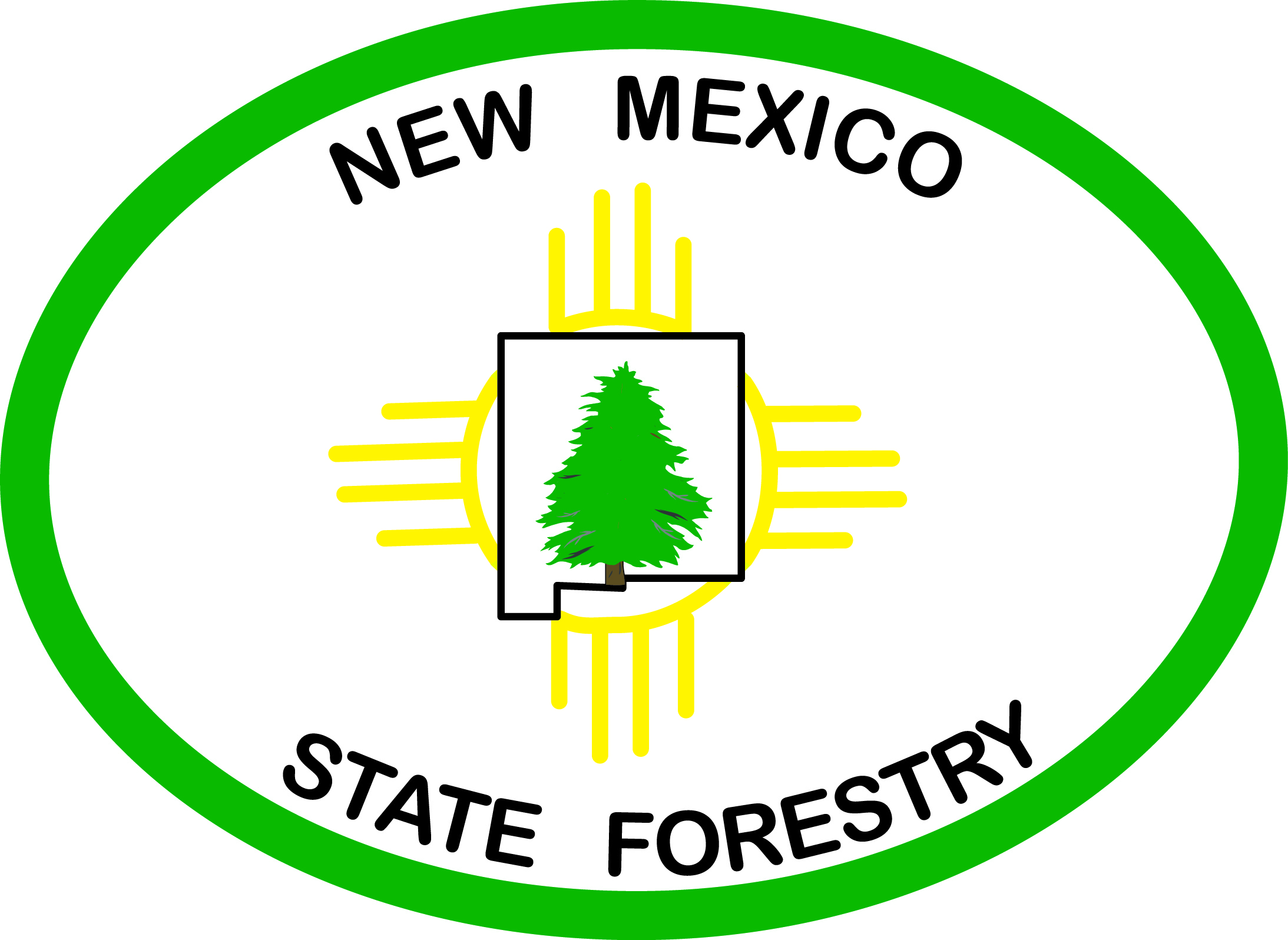 New Mexico State Forestry Division, Energy Minerals and Natural Resources
New Mexico State Forestry Division, Energy Minerals and Natural Resources
The New Mexico State Forestry Division (Forestry) retains lead responsibility for wildland fire management on non-federal and non-municipal lands, maintaining fire suppression capacities and emphasizing firefighter and public safety. Forestry promotes healthy, sustainable forests in New Mexico for the benefit of current and future generations.
 New Mexico State University
New Mexico State University
New Mexico State University is the state's land-grant university, serving the educational needs of New Mexico's diverse population through comprehensive programs of education, research, extension education, and public service.
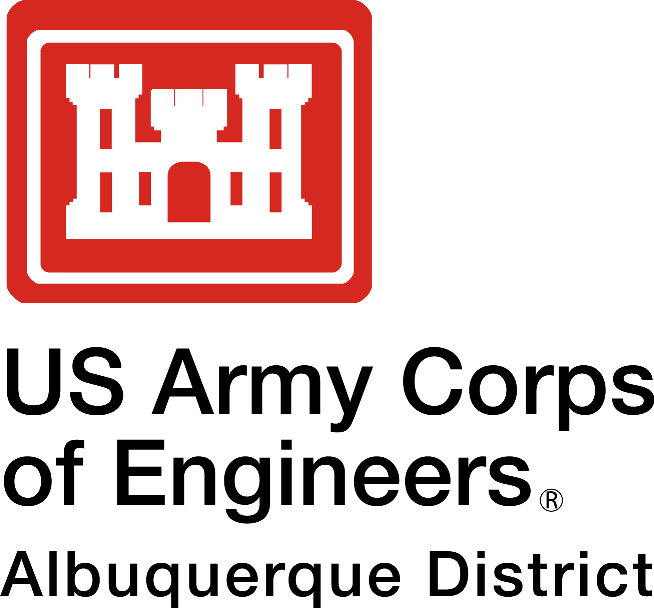 US Army Corps of Engineers
US Army Corps of Engineers
US Army Corps of Engineers
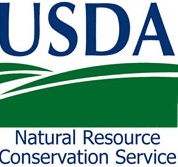 USDA Natural Resources Conservation Service
USDA Natural Resources Conservation Service
USDA Natural Resources Conservation Service
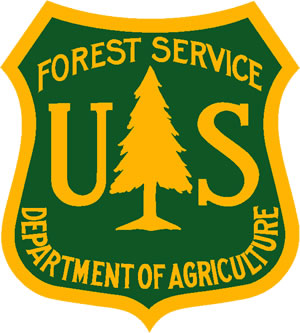 USDA Forest Service
USDA Forest Service
USDA is an equal opportunity provider, employer and lender. To file a complaint of discrimination, write to USDA, Office of the Assistant Secretary for Civil Rights, Office of Adjudication, 1400 Independence Ave., SW, Washington, DC 20250-9410, or call (866) 632-9992 (toll-free customer service), (800) 877-8339 (local or federal relay) or (866) 377-8642 (relay voice users).
Wildfire Information
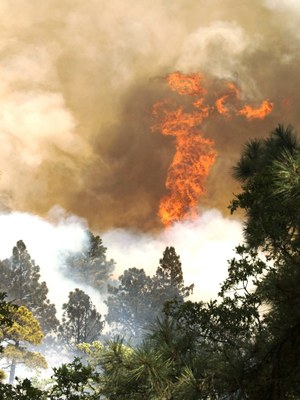 Information on Wildfires Anywhere in the U.S., including New Mexico: click here.
Information on Wildfires Anywhere in the U.S., including New Mexico: click here.
Information Focused on New Mexico Wildfires: Information specifically focused on wildfires in New Mexico can be found here.
Alerts: You can sign up to receive New Mexico State Forestry’s wildfire alert emails for timely updates about wildfires burning on state and private lands. Some county offices of homeland security and emergency management offer a free cell phone text alert service.
Emergency Alerts from Nixle: Go to this link for emergency alerts delivered to your cell phone and email at no cost.
Emergency Notification (reverse 911, CodeRED): Many communities and institutions have automated emergency notification systems that will send alerts to your cell phone. Contact your law enforcement agency to find out if a local system is available, and sign up if one is.
NOAA Fire Detection Program: Analyzed fires and smoke from satellite.
Smoke and your Health: The New Mexico Department of Health provides information to help protect your health from smoke during wildfire: click here.
Planning for Wildfire: click here.
Weather Information
NOAA's (National Oceanic and Atmospheric Administration) National Weather Service provides training and is a local resource for providing a 24/7 weather watch.
Site Disclaimer
This guide is a collaborative work by land management agencies and local government organizations in New Mexico. It is intended to be used for informational purposes only. It is not intended to substitute for legal or professional advice. The material in this guide was compiled to help community leaders find the best currently available information in one place for communities that have experienced a destructive wildfire. Readers should be aware that such information is subject to change over time and will not apply to all communities or all post-fire situations.
We recognize that the range of assistance offered to communities and individuals in New Mexico may not meet all of the many needs that can arise after a wildfire. Gaps in services and financial assistance do exist. This guide attempts to communicate to communities and individuals the ‘lessons learned’ from other New Mexico communities, outline what help is currently available, and provide some information on rehabilitation practices that may be employed after a wildfire has occurred. We hope this guide assists you on your journey of recovery from a destructive wildfire.
We welcome your feedback on this guide.
Publications and PDFs
PDF of Condensed Version of the Guide
Hot off the press! Click above to find a condensed, printable, downloadable version of the 'After Wildfire: A Guide for New Mexico's Communities."
Post-Fire Treatments PDF
Communities often do not know where to start with post-fire treatments to reduce risk from post-fire flooding or to restore burned land. This pdf contains information on post-fire treatments for burned areas after a wildfire. It is a static version of the Post-Fire Treatments section of the After Wildfire website.
 Post-Fire Treatments - A Primer for New Mexico Communities_2015.pdf
Post-Fire Treatments - A Primer for New Mexico Communities_2015.pdf
PDF document, 2617 kB (2680339 bytes)
Publications from New Mexico State Forestry
Learn about wildfire preparedness and more at New Mexico State Forestry's publication page,
http://www.emnrd.state.nm.us/SFD/Publications/PubsMain.html.
Sandbagging Techniques
The use of sandbags is a centuries old, tried and true method for flood fighting. See procedures and safety tips inside on efficient bagging operations.
 NWD_Sandbag_Pamphlet.pdf — PDF document, 6995 kB (7163293 bytes)
NWD_Sandbag_Pamphlet.pdf — PDF document, 6995 kB (7163293 bytes)
US Army Corps of Engineers Program PDF Pages USACE Section 1135
This fact sheets outline the USDA programs described in the Who Can Help - Communities section. This pdf contains more information on the US Army Corps of Engineers CAP program on Project Modification for Improvement to the Environment.
 Sec 1135.pdf — PDF document, 621 kB (636314 bytes)
Sec 1135.pdf — PDF document, 621 kB (636314 bytes)
US Army Corps of Engineers Program PDF Pages USACE Section 14
This fact sheets outline the USDA programs described in the Who Can Help - Communities section. Information on the CAP Program Section 14 about Emergency Stream bank and Shoreline Erosion Protection.
 Sec 14.pdf — PDF document, 636 kB (651642 bytes)
Sec 14.pdf — PDF document, 636 kB (651642 bytes)
US Army Corps of Engineers Program PDF Pages USACE Section 204
Fact Sheet on USACE Section 204 of the Continuing Authorities Program (CAP) used to provide comprehensive State or regional sediment management planning assistance.
 Sec 204.pdf — PDF document, 188 kB (192800 bytes)
Sec 204.pdf — PDF document, 188 kB (192800 bytes)
US Army Corps of Engineers Program PDF Pages USACE Section 205
Fact Sheet on USACE Section 205 of the Continuing Authorities Program (CAP) for flood risk management.
 Sec 205.pdf — PDF document, 604 kB (618519 bytes)
Sec 205.pdf — PDF document, 604 kB (618519 bytes)
US Army Corps of Engineers Program PDF Pages USACE Section 206
Fact Sheet on USACE Section 206 of the Continuing Authorities Program (CAP) on Aquatic Ecosystem Restoration.
 Sec 206.pdf — PDF document, 608 kB (622835 bytes)
Sec 206.pdf — PDF document, 608 kB (622835 bytes)
USGS New Mexico Debris Flow Hazard Studies
The USGS conducted debris flow hazard studies following the Whitewater-Baldy, Las Conchas and Track fires.
Models of Post-Fire Debris Flows: Want to learn more about post-wildfire flooding? U.S Geological Survey has produced three reports modeling post-fire debris flows. The reports include information such as the areas of the highest probability of the largest debris flows during flooding some recent New Mexico wildfires. You can see the completed reports at the links below. Also, USGS may help communities before or after a wildfire, including early warning rain and stream gauges and debris-flow modeling.
For more information, call (505) 830-7905 or visit the USGS Water Resources of New Mexico site here.
http://pubs.usgs.gov/of/2012/1188/ofr2012-1188.pdf (Whitewater-Baldy)
http://pubs.usgs.gov/of/2011/1308/ (Las Conchas)
http://pubs.usgs.gov/of/2011/1257/ (Track Fire)
FAQs
Is there a paper version of this guide?
This website is designed to be printed: you can print a short pdf version or the entire website here. Each section can also be printed separately. The website offers the most up-to-date and comprehensive information, however.
Who can help after a wildfire?
The Who Can Help section contains the array of known help in a post-wildfire situation for both communities and individuals. There may not be assistance for every specific situation.
What are some steps my community can take to help us recover?
Navigating after a disaster is challenging. We have compiled some helpful tips to get you started and to assist you on your journey to recovery in the Mobilize Your Community section.
What are other key tools and resources?
Some highlighted resources include recovers.org to assist a community in organizing after a disaster, and the ‘After the Fire’ toolkit, which provides customizable communication tools such as sample press releases and door hangers for communities. See Additional Resources for more.
Is this guide useful for other states outside of New Mexico?
Yes. In the first year, the guide was used more frequently by other states. Many of the resources pertain to the United States, while some resources are local. The post-fire and flooding sections are written mainly for the southwest, but may be useful in other areas as well.
Can a BAER (Burned Area Emergency Response) Team help?
The focus of BAER Teams is public land. They work to mitigate the after effects of wildfire, such as flooding. While this often helps protect areas downstream, BAER Teams rarely have the authority or permission to work on private land. Likewise, the US Forest Service has a mandate to work on their public land, and has limited ability to work on private land.
How can I give feedback on this guide or contact the guide administrators?
Click on contact in the footer for questions, ideas or input about this website or the paper guide.
Can someone present the ‘After Wildfire’ guide at my conference or for my community?
Sometimes. We have limited staff and trained professionals to present the guide. We can sometimes present at conferences in New Mexico and to nearby communities depending on availability.
What are some of the main lessons learned from the After Wildfire guide?
- Communities that have worked together before a disaster can mobilize more rapidly and effectively if/when a disaster does strike.
- While help exists, there are also gaps in assistance, as agencies have specific parameters for the programs and services they provide.
Printed Materials
Print Condensed Booklet of the Guide
PDF of Condensed Version of the Guide
Printing the Entire Website Online
To download entire Online Guide: http://afterwildfirenm.org/report_print
To print individual sections, look for this button ![]() in every section
in every section
To print a page, look for this button  on every page.
on every page.
Print the Guide by Sections:
Immediate Safety - http://afterwildfirenm.org/immediate-safety/report_print_section
Mobilize Your Community - http://afterwildfirenm.org/mobilize-your-community/report_print_section
Who Can Help - http://afterwildfirenm.org/who-can-help/report_print_section
Post Fire Treatments - http://afterwildfirenm.org/post-fire-treatments/report_print_section
Financial Tips - http://afterwildfirenm.org/financial-tips/report_print_section
Flood Information - http://afterwildfirenm.org/flood-information/report_print_section
Additional Resources - http://afterwildfirenm.org/additional-resources/report_print_section
Printed Materials
For copies of the following materials (while supplies last),
contact New Mexico State Forestry’s Forest and Watershed Health Office at 505-345-2200.
- Infographic Postcard
- Infographic Letter Size
- Infographic Mini Poster



